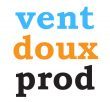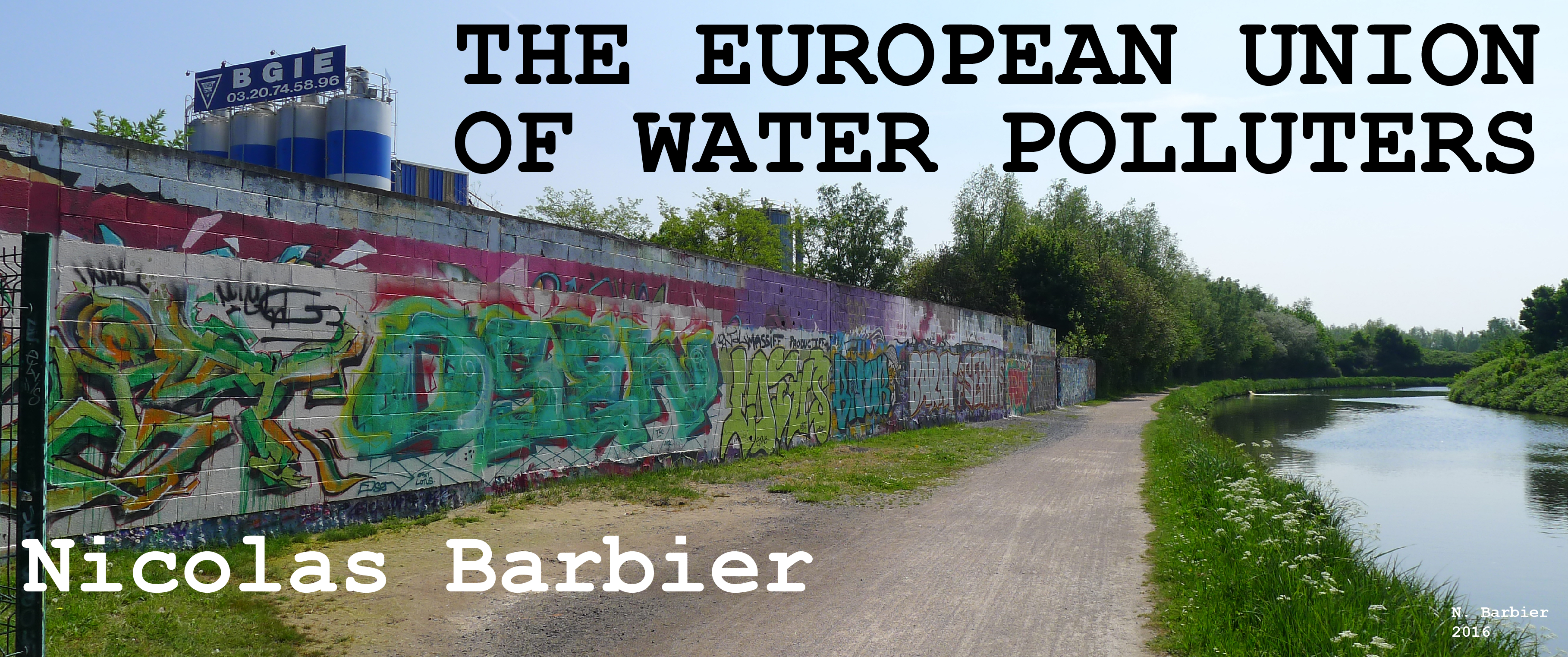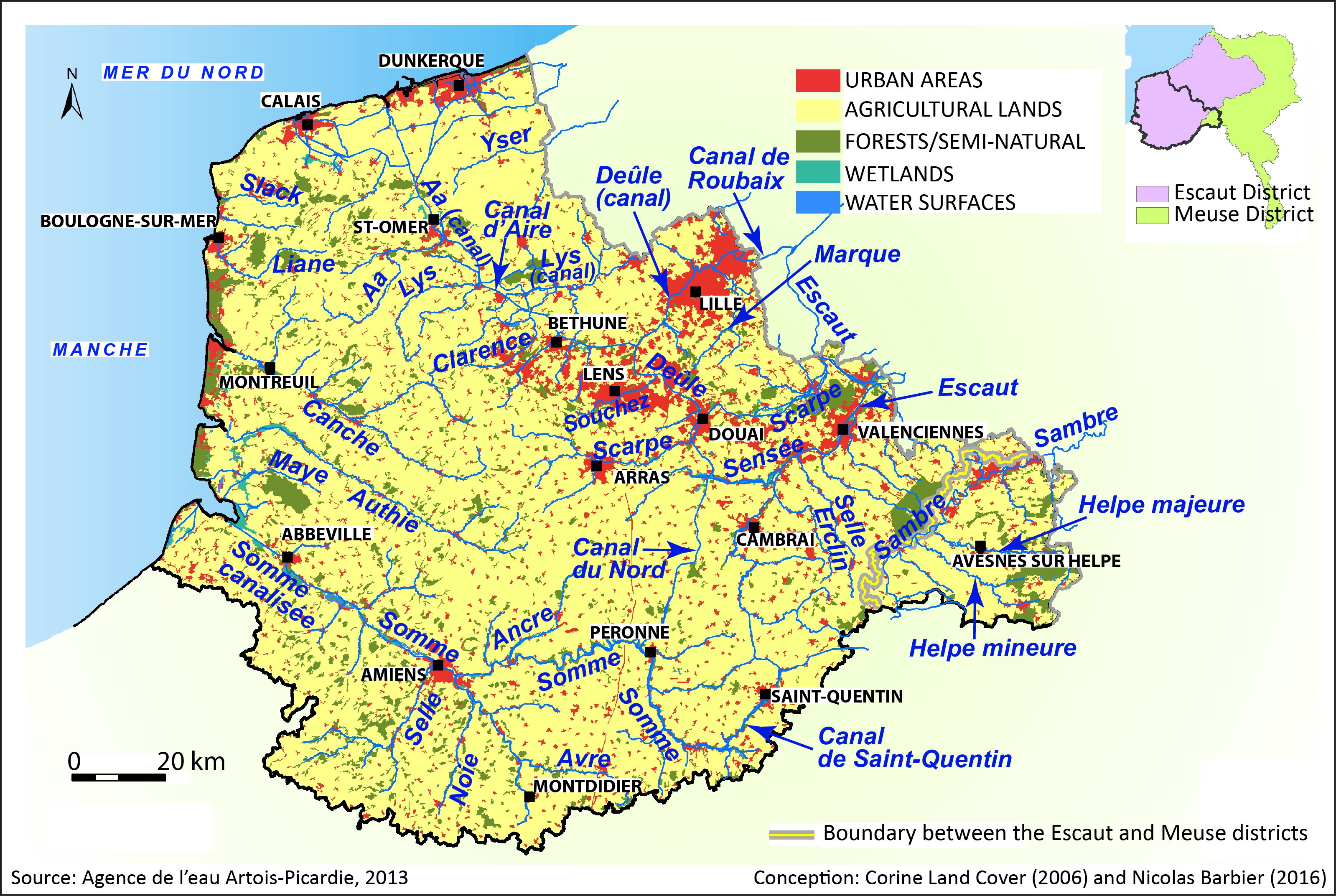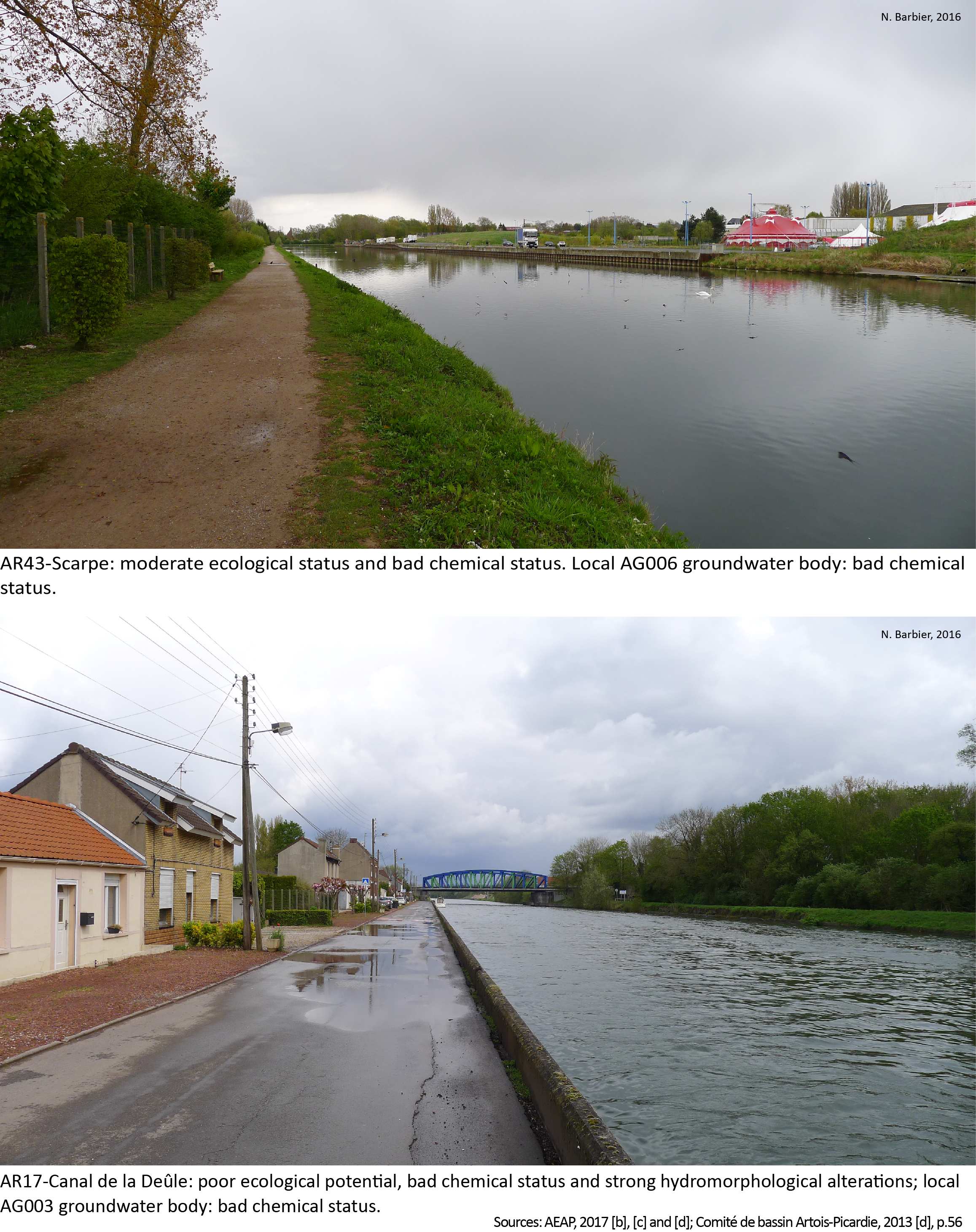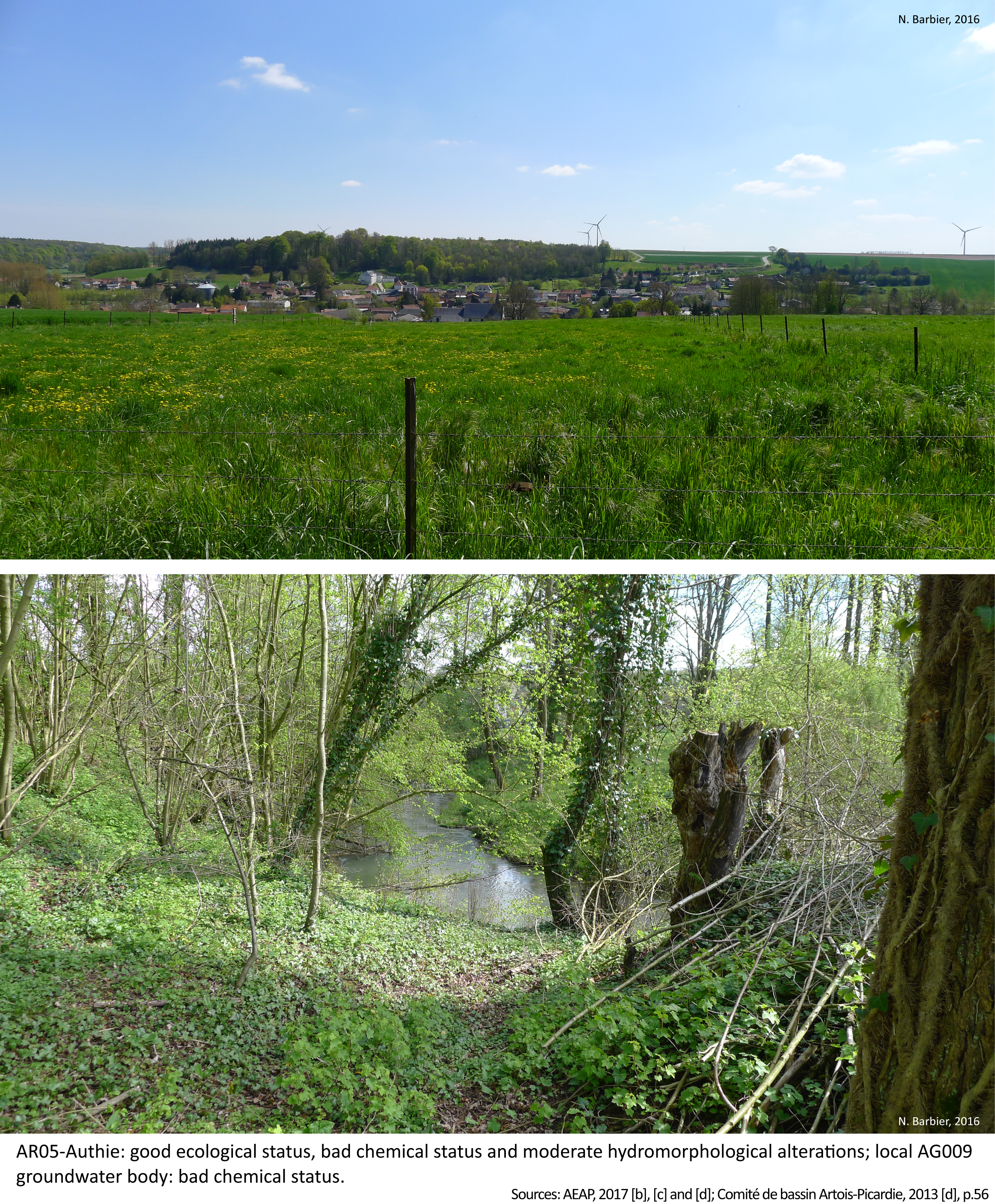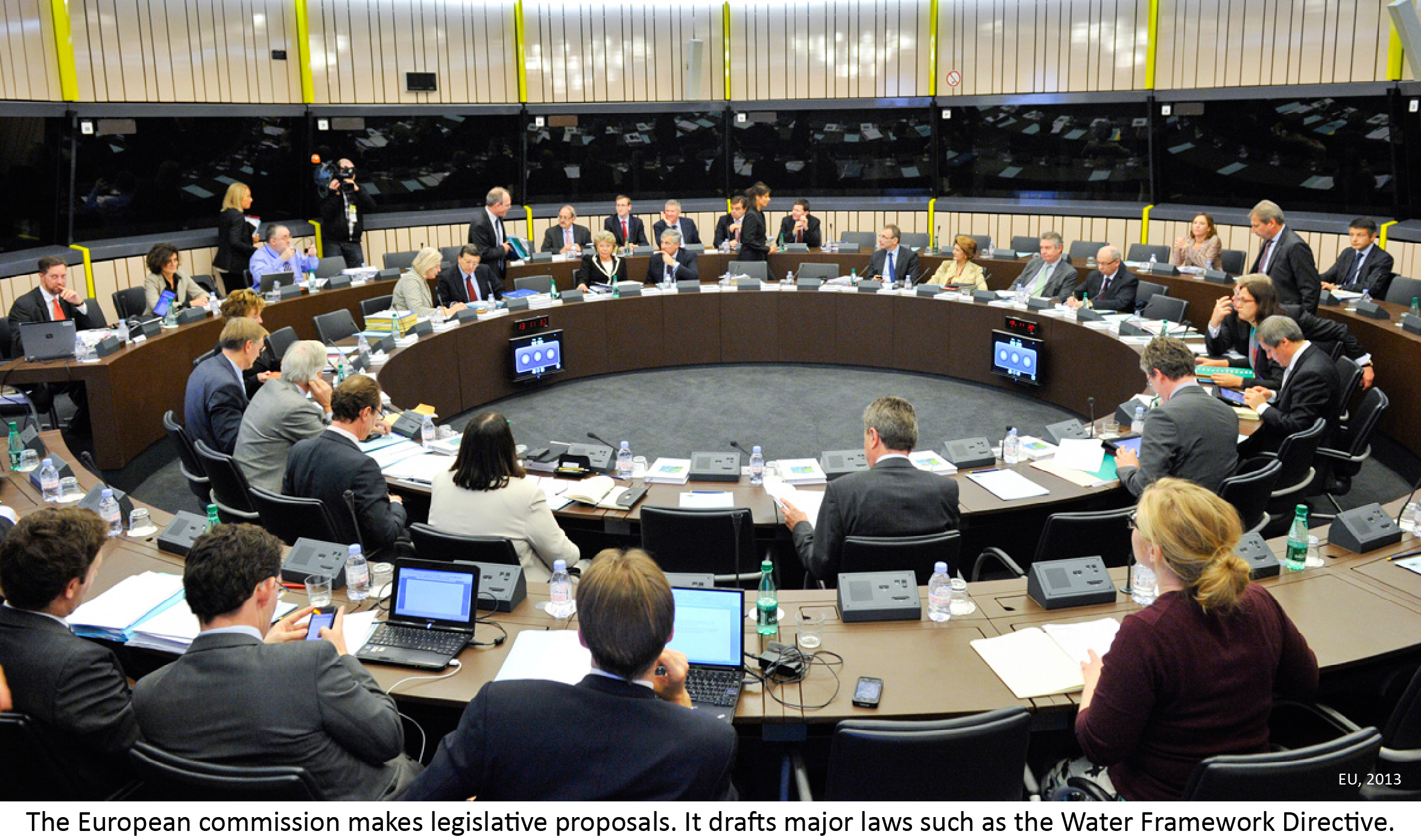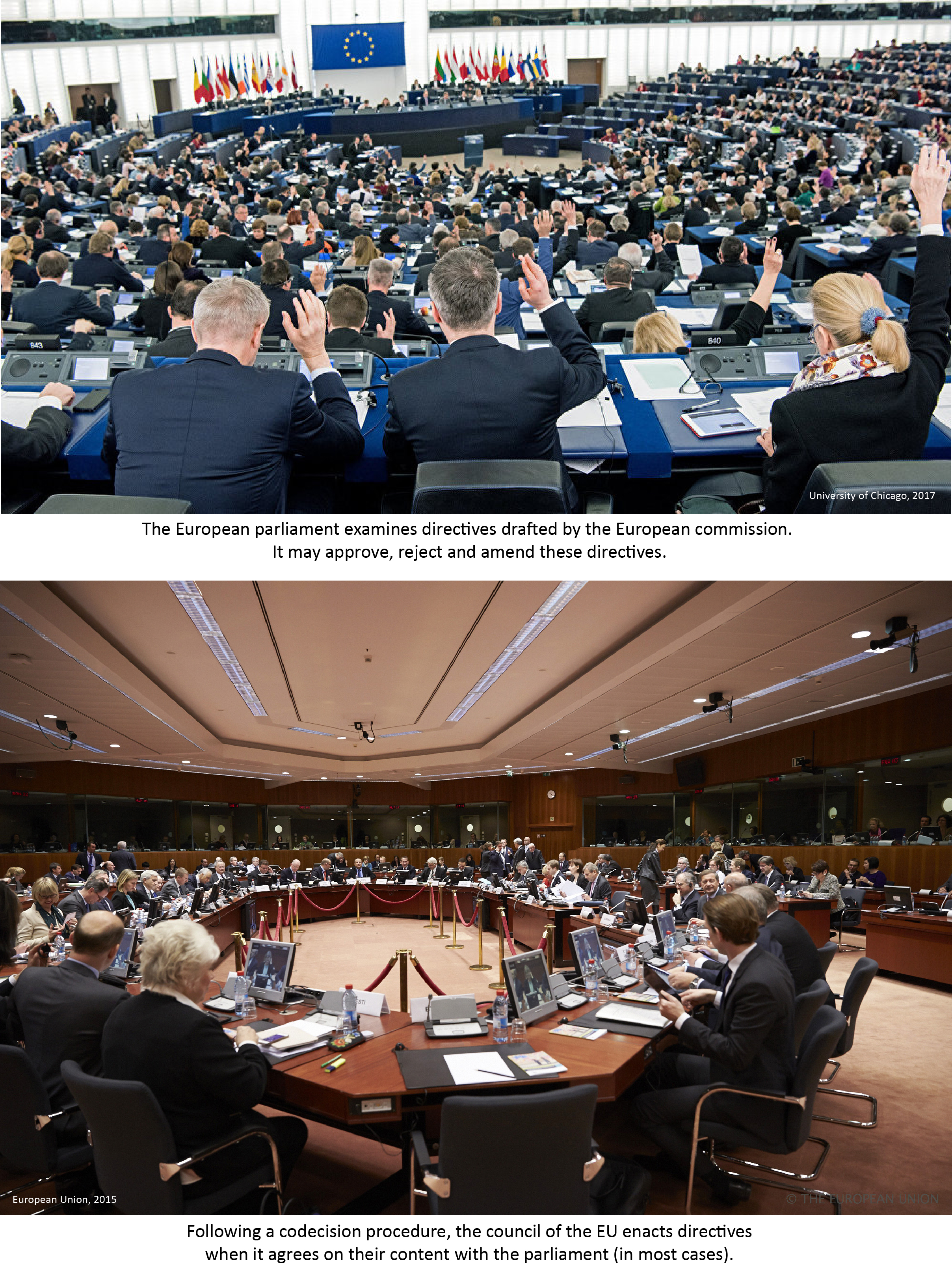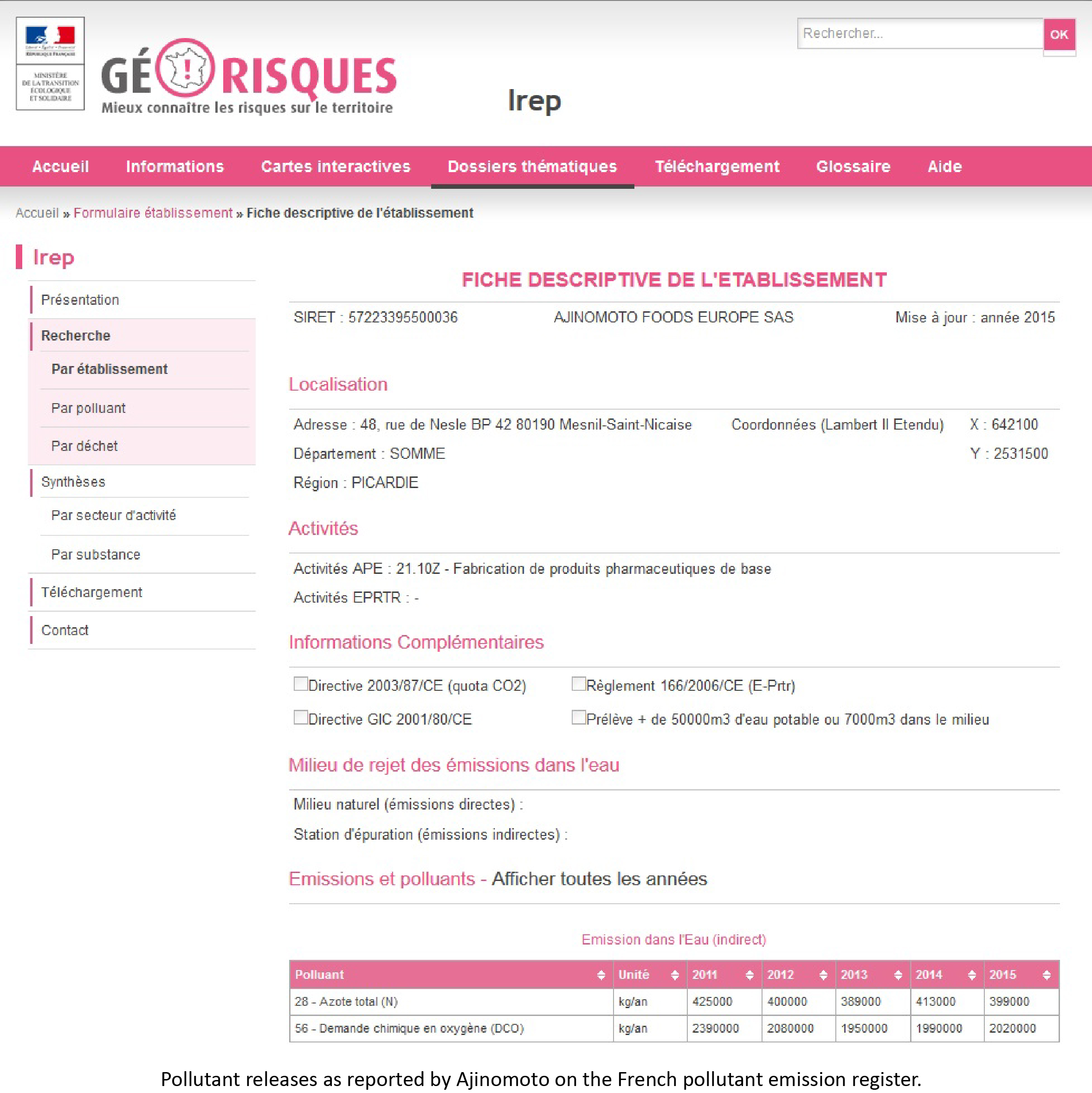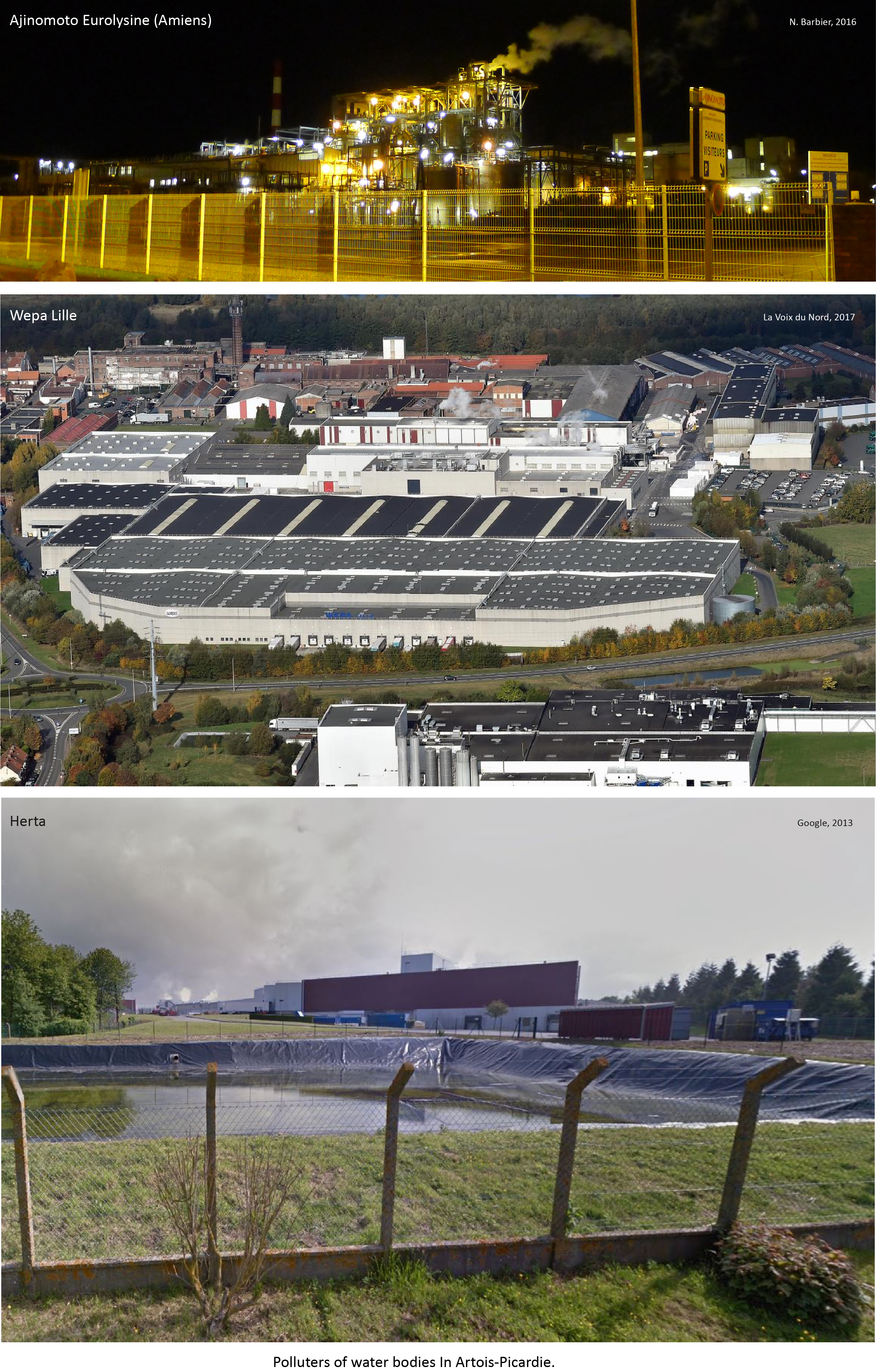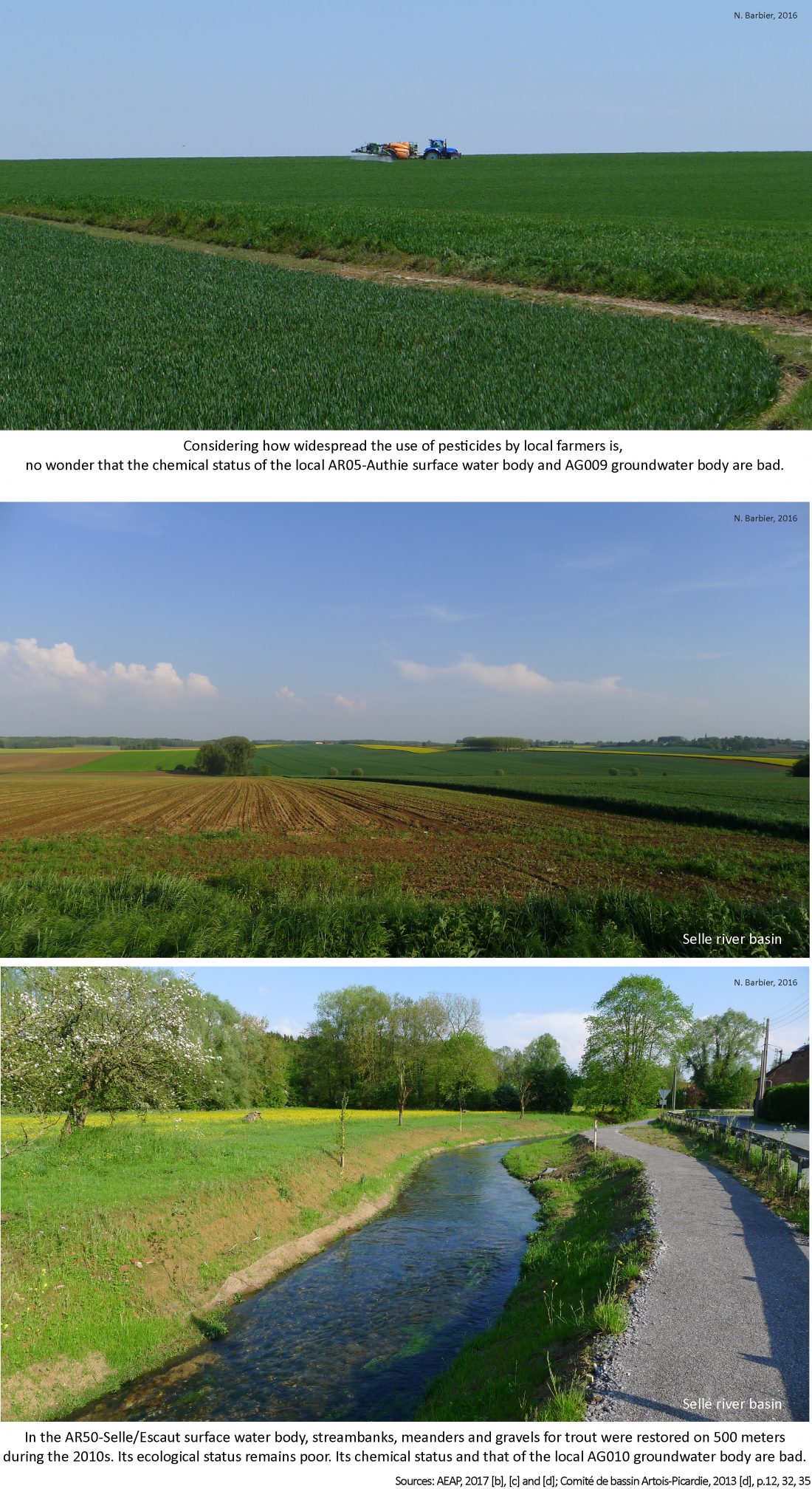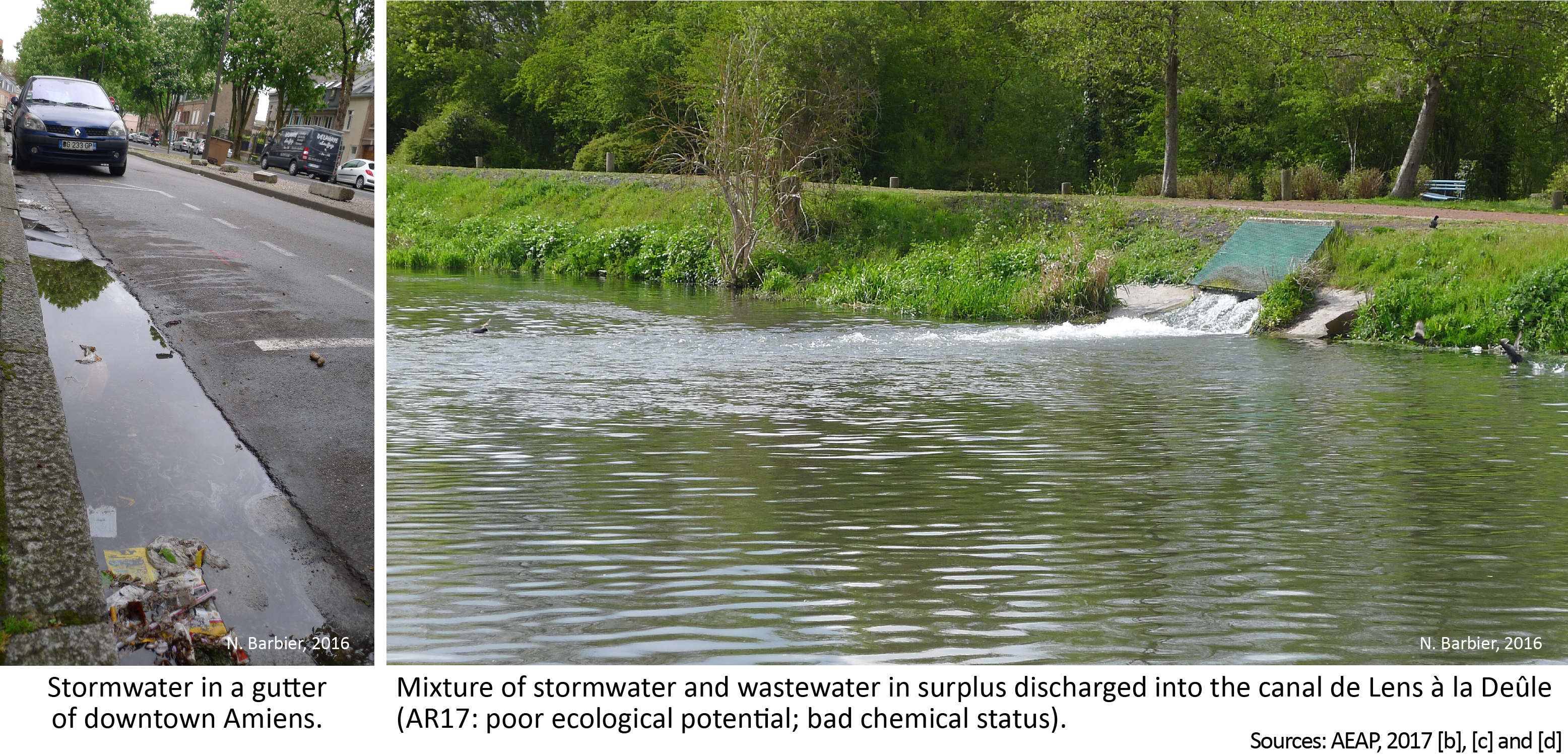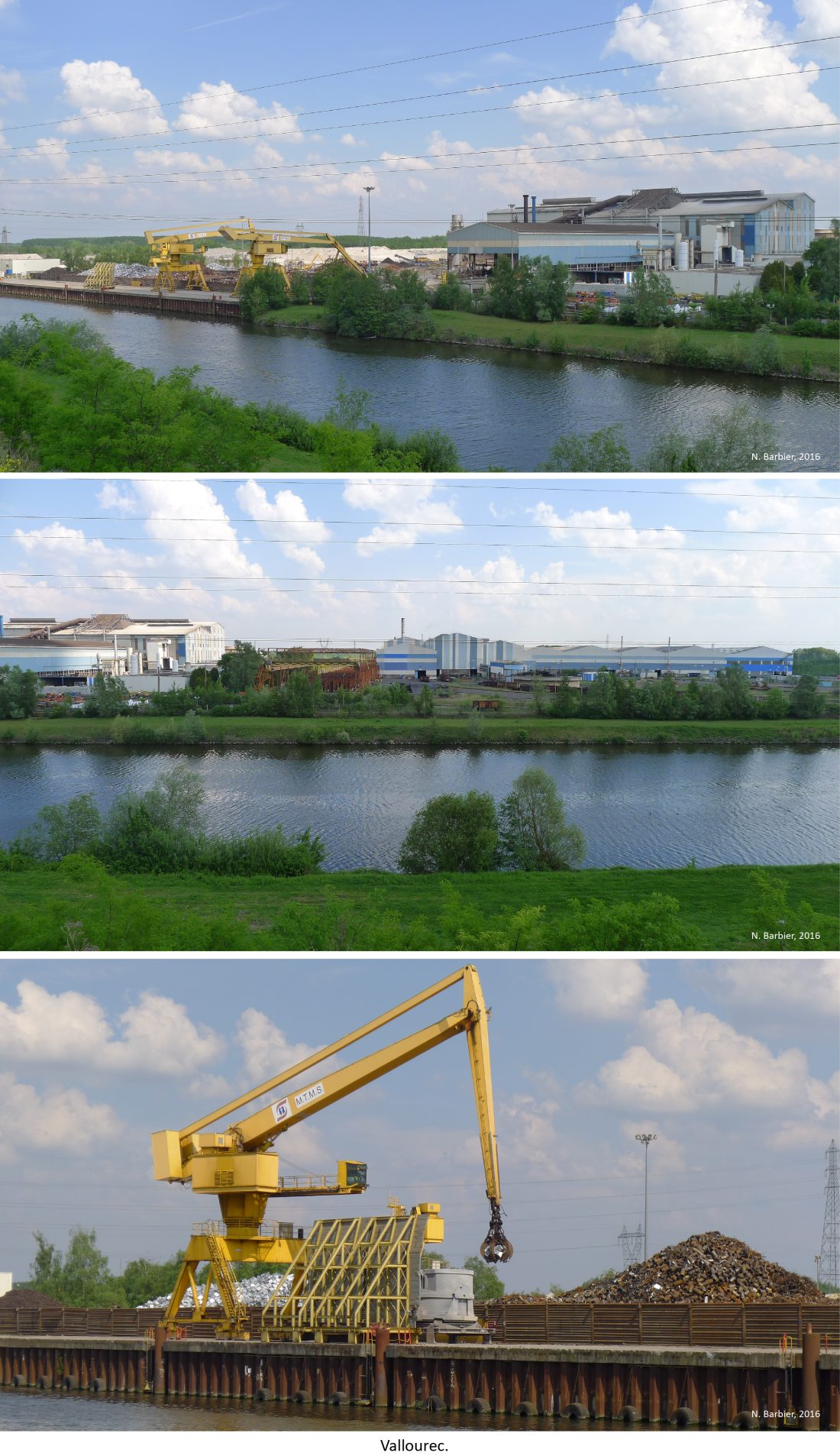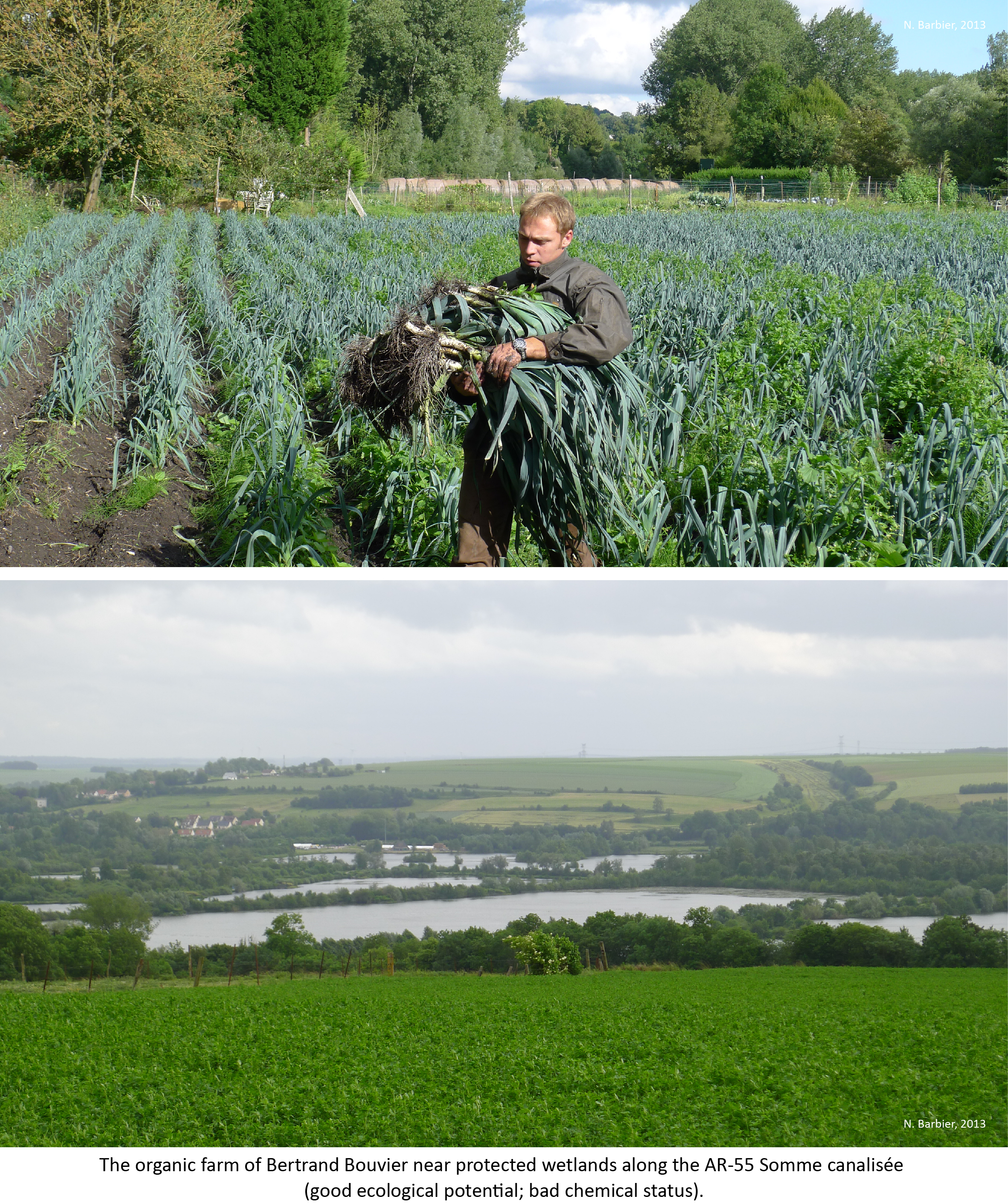USUALLY, NEITHER JOURNALISTS NOR SCIENTISTS TELL YOU THE TRUTH about the law of the European Union (EU) related to the quality of groundwater and surface water. Typically, they merely address small fragments of the law. They focus neither on the core of the law nor its critical elements. Within the EU, the commercial, financial, judicial, industrial and political ruling classes all have a vested interest in downplaying or hiding water pollution due to EU law. I explore the hidden depths of this law. I emphasize key legal paragraphs responsible for continuing pollution of groundwater and surface water and for the countless aquatic ecosystems in poor environmental conditions. I give examples of the impacts of that toxic law in a river basin district I know well for having lived there for years: Artois-Picardie in northern France. I sometimes look at other basins within the EU. Lawmakers knowingly mislead people into believing that their law protects water quality. I clarify the content of that law so that everyone could understand how it perpetuates the unacceptable poisoning of our common source of life.
Buy PDF (€5.00)
Buy eBook (.epub and .mobi) (€8.00)
Subscribe to my newsletter
About the bibliography
I CONSIDER THAT READERS SHOULD BE ABLE TO VERIFY MY SOURCES. This is why you can find all my bibliographical references at the end of each paragraph, including the page, article or annex number of references when applicable. The entire bibliography is at the end of this investigation.
I. The legal source of water pollution
THE LEGISLATORS OF THE EUROPEAN UNION (EU) INJECT THEIR IDEOLOGY INTO THEIR LAWS on water bodies. In the EU’s countries, citizens give birth to national governments through different electoral procedures. By voting, they elect a president, a head of government and/or a parliamentary assembly. In addition, citizens elect members of the European parliament (MEPs). The citizens, governments and MEPs are the creators of the European union of polluters.
EU legislators are split into three institutions: the European commission, the council of the EU and the European parliament. The EU member states’ national governments exert a strong influence on both the commission and council.
- Every 5 years, the European council (made up of EU heads of State and government) proposes a commission presidential candidate to the European parliament. If an absolute majority of members of Parliament support the nominee, he or she is elected. The president-elect selects commissioners based on suggestions from EU countries with one commissioner per EU member State. The list of nominees has to be approved by all EU heads of State or governments meeting in the European council. The parliament then votes whether or not to approve the entire team. Finally, the commissioners are appointed by the European council.
- In different groups based on fields of competence, the council of the EU brings together all ministers of member states.
- Every five years, MEPs are elected by direct universal suffrage (Union Européenne, 2014; Vie publique, 2016 [b] to [e]).
How is a major law like the Water Framework Directive (WFD) of 2000 passed?
- The commission first drafts the directive which is then examined by the European parliament. The latter has authority to amend it.
- The council of the EU enacts the directive if it agrees with the parliament. Otherwise, the parliament must reexamine it.
- With a few exceptions, the council and parliament have got to get their act together (Union Européenne, 2014; Vie publique, 2016 [b] to [e]).
Through this legislative procedure, EU legislators have been passing laws that have deeply affected the quality of water bodies.
II. The sad reality of water bodies in Artois-Picardie… and elsewhere
MANAGERS TALK ABOUT WATER BODIES ALL THE TIME. Convenient for experts, this expression may be misleading for others. A groundwater body means a volume of water in one or more aquifers[1]. A surface water body is a distinct and significant part of surface water, which means all or part of a river, canal or lake (Comité de bassin Artois-Picardie, 2013 [a], p.13-14, 24 et [d], p.4; EauFrance, 2015 [a]; Sandre, 2015).
In 2017 in the Artois-Picardie river basin district[2] (map 1), the status of 66 to 87 percent of water bodies is moderate (i.e., average status or a slightly less), poor or bad. More specifically in this district, the chemical status of 87 percent of its surface water bodies and 66 percent of its groundwater bodies is bad. For 76 percent of surface water bodies, the ecological status or potential ranges from moderate to bad. Only 24 percent of surface water bodies have a good ecological status (i.e., slightly impaired ecological processes and aquatic ecosystems) or good ecological potential. In this basin district of 20,000 square kilometers and 4.8 million inhabitants located in northern France, high ecological status is nonexistent. Moreover, out of 66 river water bodies, only one shows minimal hydromorphological alterations while substantial alterations are prevalent (photos 1). Agriculture, industrial activities, wastewater systems as well as degraded ecosystems are blamed for this sad environmental record (AEAP, 2016 [e], p.4-5; Comité de bassin Artois-Picardie, 2013 [a], p.27, 33, 42-43, 70, 2013 [d], p.56; Comité de bassin Artois-Picardie, 2015, p.50, 69-70; Préfet coordonnateur du bassin Artois-Picardie et AEAP, 2014, p.46).
Map 1. The Artois-Picardie river basin district
Photos 1
In the EU, Artois-Picardie is by no means an isolated case. East Aegean (southern Bulgaria), Guadiana (central Spain, photos 2), Lielupe (Latvia), Neagh Bann (Ireland), Rhine (Netherlands), Saxony (southern Germany) and Weser (northern Germany, photos 2) are just a few basin districts where the ecological status or potential of most water bodies ranges from moderate to bad. In Belgium (Flanders), the Czech Republic, northern France, Germany, Hungary, the Netherlands, Poland and several individual river basin districts, more than 70 percent of surface water bodies (rivers and lakes) are in “less than good” (i.e., moderate, poor or bad) ecological status or potential. In Austria, in most of Greece, Ireland, southern Bulgaria and northern Italy, at least 50 to 70 percent of surface water bodies bare the same burden (European environment agency, 2017 [a], [c] and [d]).
Photos 2
Over and above this, the assessment of the status of water bodies is deceptive.
III. The unreliable assessment of water status
ACCORDING TO THE WFD, the chemical status of a surface water body is either good or bad. Out of tens of thousands of chemicals available on the EU marketplace and used daily, the European parliament and council of the EU have established concentration thresholds in surface water bodies for only 53 of them, including 45 priority substances. When none of the 53 substances exceed their legal concentration thresholds in a surface water body, the chemical status is deemed good. In 2017, the list of 53 substances includes metals (e.g., cadmium, mercury, lead), pesticides (e.g., aclonifen, isoproturon, trifluralin), hydrocarbons (e.g., benzene, dioxins, fluoranthene) and solvents (e.g., dichloromethane) (Agence de l’eau Loire-Bretagne, 2015; Agence de l’eau RMC, 2013; DRIEE Ile-de-France, 2011; European parliament and council of the EU [EP and CEU], 2013, annexes I and II).
Groundwater chemical status is either good or bad as well. By law in the EU, the concentrations of at least thirteen categories of pollutants must be measured in each water body. These categories are ammonium (concentration threshold of 0.5 mg/l in France)[3], arsenic (10 µg/l), cadmium (5 µg/l), chloride (250 mg/l), mercury (1 µg/l), nitrates (50 mg/l), nitrites (0.50 mg/l), pesticides (0.1 µg/l individually and 0.5 µg/l for all pesticides), lead (10 µg/l), phosphorus or phosphates, sulphate (250 mg/l), trichlorethylene (10 µg/l) and tetrachloroethene (10 µg/l)[4]. If the concentration of one pollutant exceeds a threshold, the chemical status is considered bad. If not, it is deemed good when two additional conditions are met: the concentrations of the thirteen categories of pollutants do not prevent connected surface water bodies from reaching good status or good potential; they do not cause the effects of salt water intrusion[5] or other problems in terms of conductivity[6] for example[7] (EP and CEU, 2014; EP and CEU, 2006, annexes I and II; EP and CEU, 2000, annex V – 2.3; Ministère de l’écologie, du développement durable et de l’énergie [EDDE], 2012 [a], annexe II and 2012 [b], p.46).
So only a tiny minority of existing polluting substances are measured to assess water chemical status. And they are only measured individually. Therefore, the harmful impacts of their combination on water bodies are totally ignored. In such conditions, the assessment of water chemical status is an intellectual fraud and a deliberate lie backed by all EU member states and EU institutions (Agence de l’Eau Loire-Bretagne, 2015 ; EP and CEU, 2013, annexes I and II; EP and CEU, 2000, annex V – 2.3).
The shortcomings of the evaluation of the ecological status of water bodies are of lesser magnitude. Evaluators measure the concentrations of nitrogen, phosphorus, four metals (arsenic, chromium, copper, zinc) and five pesticides (2,4D, chlortoluron, linuron, MCPA, oxadiazon). In addition, they control the acidity of water[8], its salinity, temperature, and dissolved oxygen concentration. The evaluation further encompasses invertebrate, fish and plant populations as well as hydromorphological alterations. For a river, the level of these alterations is assessed by measuring its width, depth, bed slope, currents, streambanks and ecological continuity (i.e., free movements of animal species and good sediment transport). The ecological status of a surface water body obtained is then compared with conditions of similar surface waters with little or no impact from human activities (baseline conditions). By measuring the gap between the status obtained and baseline conditions, evaluators get the final ecological status (high, good, moderate, poor or bad) (Comité de bassin Artois-Picardie, 2013 [a], p.26; EauFrance, 2016 [c]; EP and CEU, 2000; Ministère de l’écologie, de l’énergie, du développement durable et de la mer, 2010, annexe 1; Ministère de la transition écologique et solidaire [TES], 2017 [a]; Secrétariat technique, Rhône-Méditerranée, 2011).
Looks pretty good? Then consider the following. In Artois-Picardie, the assessment of ecological status either completely ignores or does not adequately take into account: the extinction of otters and beavers; the scarcity of salmon and eels; the fragmentation of old-growth forests (i.e., areas continuously forested for at least 250 years); the disappearance of primary forests. These species and forest types used to be common in many regional watersheds. They significantly contributed to biodiversity and food webs in aquatic ecosystems and could influence the physico-chemical properties of surface water (AEAP et al., 2015, p.43-44; CRPF Poitou-Charentes, 2017; Decocq, 2012; Ministère TES, 2017 [b]; ONCFS, 2017; Préfecture de la région nord, 2007, p.13-16; Veron, 1992).
In an article published in 2017, a group of thirty-five researchers[9] suggested ways to improve the assessment of the status of water bodies. They recommend the use of effect-based-tools like bioassays[10] in order to detect the cumulative effects of a mixture of chemicals, and especially their interactions with aquatic organisms. Good idea. But guess what, even this group of recognized scientists does not put forward practical ways to drastically reduce or ban the use of most existing pollutants. They just want a better assessment and “reduce the chemical footprints of man-made practices”. What is the point of merely suggesting a better assessment that lots of scientists already know of? What is the point if their proposal is not supplemented with a well thought out plan for the elimination of most of these chemical footprints? The thirty-five researchers even declare in their conclusion: “The WFD […] has successfully safeguarded the protection, restoration, and sustainable use of EU water resources” (Brack and al., 2017). They started with a good idea (a better assessment) and ended up with a lie about EU law: the WFD does not safeguard the protection, restoration, and sustainable use of EU water resources. This being said, the assessment of the status of water bodies might get better by 2020. But it will not dramatically improve the chemical status of water bodies until most chemicals causing pollution are banned or their use drastically reduced by law. Tens of thousands of them.
Beside the flawed assessment of water status, EU legislators have created a potent legal instrument to minimize investments in the restoration of water bodies: designating water bodies as artificial or heavily modified. That designation leaves them crippled.
IV. Tapping into a manmade environmental weakness
EU LEGISLATORS HAVE MANAGED TO FACILITATE THE MARGINALIZATION OF A LARGE PART OF RIVER WATER BODIES. They have done so by creating a category of partly and often largely irrecoverable surface waters: the artificial or heavily modified water bodies. An artificial water body was created by human activity. The legal definition of heavily modified water body is a little more specific: it is the result of physical alterations by human activity that substantially changed its character. Until 2015 in Artois-Picardie, twenty river water bodies were artificial (5) or heavily modified (15). These rivers were turned into canals long ago. In 2016, the prefect coordinator of Artois-Picardie (the highest regional civil servant) relegated nine additional water bodies into the artificial or heavily modified category. As a result, 44 percent of the regional river water bodies (29 out of 66) are now ranked in that substandard category (photos 3) (Comité de bassin Artois-Picardie, 2015, p.47-59 et 2013 [a], p.20; EP and CEU, 2000, article 2).
Photos 3
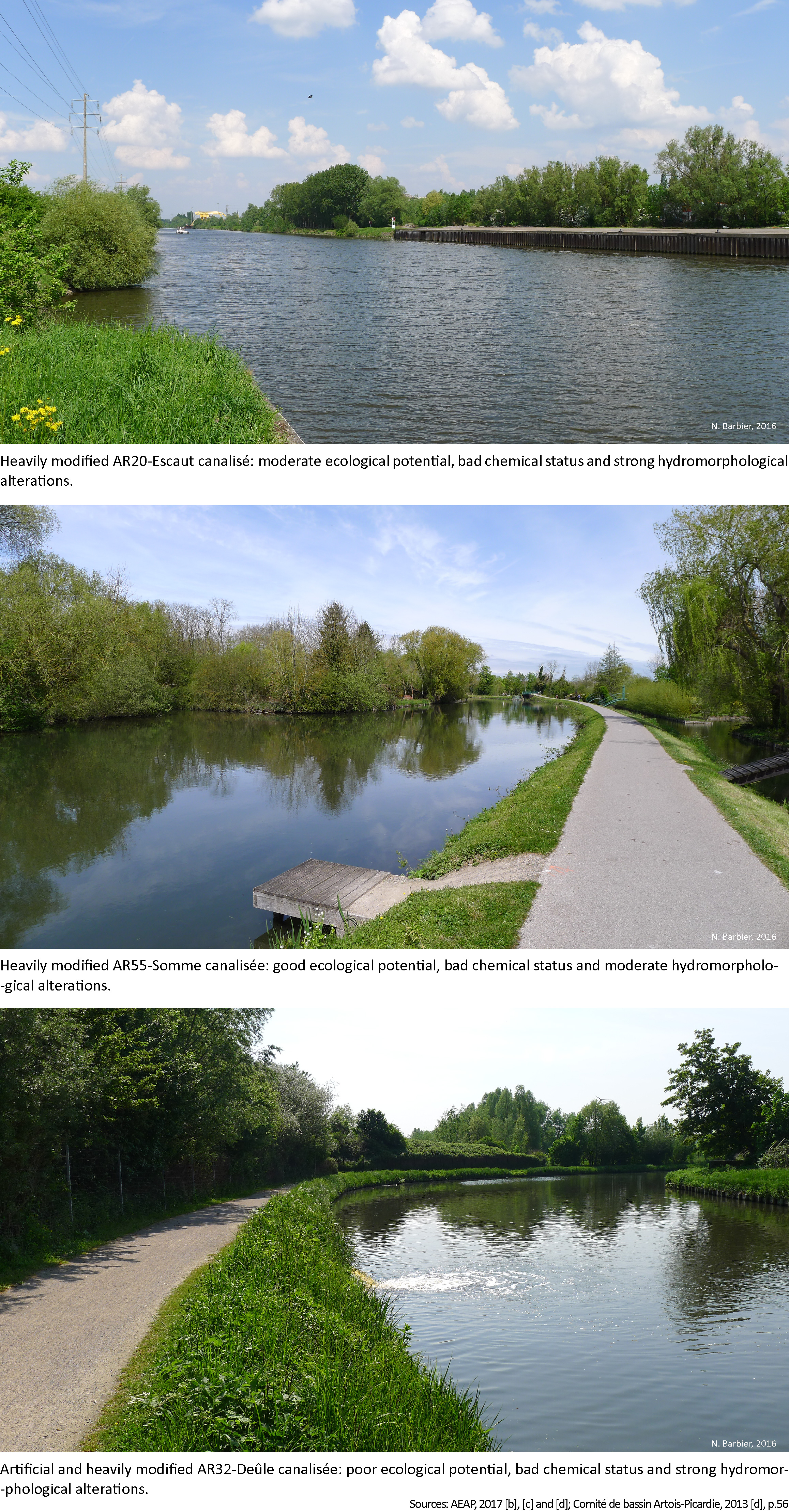 Evaluators do not assess the ecological status of artificial or heavily modified water bodies. Instead, they estimate their ecological potential (from bad to maximum) which includes the measurement of physicochemical quality elements (e.g., nitrogen, phosphorus, four metals, dissolved oxygen concentration). However, unlike the status, evaluators of the potential can ignore key morphological conditions such as riverbed slopes, banks, particle size in river bottoms, currents, flow variation and ecological continuity. This disregard for morphological conditions is a critical flaw because they are essential for the diversity and quality of wildlife habitat. The ecological potential also allows less stringent standards in terms of abundance and diversity of aquatic fauna and flora (EauFrance, 2015 [a]; Etat français, 2016 [d]; EP and CEU, 2000; European Center for River Restoration, 2014).
Evaluators do not assess the ecological status of artificial or heavily modified water bodies. Instead, they estimate their ecological potential (from bad to maximum) which includes the measurement of physicochemical quality elements (e.g., nitrogen, phosphorus, four metals, dissolved oxygen concentration). However, unlike the status, evaluators of the potential can ignore key morphological conditions such as riverbed slopes, banks, particle size in river bottoms, currents, flow variation and ecological continuity. This disregard for morphological conditions is a critical flaw because they are essential for the diversity and quality of wildlife habitat. The ecological potential also allows less stringent standards in terms of abundance and diversity of aquatic fauna and flora (EauFrance, 2015 [a]; Etat français, 2016 [d]; EP and CEU, 2000; European Center for River Restoration, 2014).
Hydromorphological restoration is not impossible in designated heavily modified water bodies. But there is a powerful deterrent to restoration work: it must never block the human activities that motivated the designation. EU member states determine, on the basis of economic or technical reasons, the activities that justify this designation. In order to validate a designation in compliance with the WFD, a member state has to meet one of these two conditions:
- Only that designation enables the achievement of the good ecological potential and helps avoid technical infeasibility or disproportionate costs. Neither the technical obstacles nor the disproportionate costs are explained in the WFD.
- The EU member state gives one justification for the designation that is conform to the WFD. Thus, a state can legally abandon hydromorphological modifications “necessary for achieving good ecological status”. It has the right to abandon these modifications when they have “significant adverse effects” on certain services like recreation, land drainage, power generation, water flow regulation, flood protection, etc.
In Artois-Picardie, “significant adverse effects” on flood protection and recreation are used as a justification in several water bodies (e.g., canal de Roubaix, Lys canalisée, Scarpe canalisée). The conservation of recreational activities at the expense of ecological restoration speaks for itself. Flood protection is a convenient legal justification which may also reveals disinvestment in urban planning, environmental and water management (e.g., inadequate reforestation and wetland restoration; cities that are too dense). States can use flood protection as a justification while leaving people and businesses in flood-risk areas. In the summer of 2014, parts of northern, central and southeastern Europe experienced devastating floods that killed several persons. North Rhine-Westphalia in Germany where 60 percent of surface water bodies are artificial or heavily modified was especially affected. In the Spring of 2016 in northern Artois-Picardie, natural disaster was declared in 90 municipalities due to flooding, lots of which are located in artificial or heavily modified water bodies (photo 4) (AEAP, 2015 [g]; AFP et France 3 Nord, 2016; Comité de bassin Artois-Picardie, 2015, p.47-59; Davies, 2014; EauFrance, 2015 [a]; EP and CEU, 2000, article 4 and annex V; Etat français, 2016 [d]; Ministère de l’égalité, des territoires et du logement et ministère EEM, 2012; Wuppertal Institut, 2017).
Photo 4
EU member states can also use water flow regulation as a justification to designate artificial or heavily modified water bodies. They are thus free to adjust water flows to the whims of industries, inland navigation and shipping companies. According to EU law, it matters not that this type of water flow regulation disrupt the natural variability of streamflow, thus affecting numerous species, biological communities and water quality. Moreover, it is possible to classify a water body as artificial or heavily modified just to protect hydroelectric power generation. EU legislators have passed over the opportunity to favor wind, solar and hydro-kinetic power over hydroelectric dams even though they could have prevented the renewal of operating licenses for aging dams. Perhaps even worse, EU member states have another sweeping legal power to avoid hydromorphological modifications necessary for achieving good ecological status. They have the power to designate artificial or heavily modified water bodies when such modifications have “significant adverse effects” on “the wider environment”. The latter may be an aquatic environment deteriorated for decades that states refuse to restore for economic reasons. In short, intentionally neglecting water bodies through the artificial or heavily modified category is made easy by the WFD (Baran, 2008; EP and CEU, 2000, article 4).
In 2016 in Artois-Picardie, regional decision-makers came up with EU-backed justifications to put nine additional water bodies in the artificial or heavily modified category. The presence of densely urbanized areas for the Flamenne water body may appear to be warranted for the time being. However, decision-makers could have drafted a 50-year plan to make the necessary hydromorphological modifications and thus avoid the designation. Two other justifications for designating five other water bodies (Erclin[11], Grande Becque, Marque, Tarsy, Yser) are changes in river beds and banks as well as channel straightening. Designation was also justified by dikes (Clarence) or the heightening of the river bed (Cologne, Scardon). Changes in river beds and banks accelerate the flow of water. They damage or obliterate riparian vegetation and fish habitat. Channel straightening, dikes and the heightening of river beds eliminate or impair ecosystems. These past alterations are not unchangeable and restoration of affected water bodies is possible. In reality, the justifications for new artificial or heavily modified water bodies prove the decision-makers’ refusal to invest significantly in ecological restoration[12] (Comité de bassin Artois-Picardie, 2015, p.47-59; Comité de bassin Artois-Picardie, 2013 [a], p.20; EauFrance, 2015 [a]).
In the EU, the poor ecological condition of countless aquatic ecosystems fits well with a deceitful sustainable growth and a law written in favor of polluters making tons of money.
V. Deceitful sustainable growth and privileges for polluters
ACCORDING TO THE EUROPEAN COMMISSION (photo 5), “SUSTAINABLE GROWTH” IS COMPATIBLE WITH THE PROTECTION OF THE ENVIRONMENT. Indeed, in an environment seriously degraded in immense regions, one just have to protect what is degraded while pursuing the primary goal of “sustainable growth”. The commission sees no contradiction between “sustainable growth” and the need to prevent further depletion of biodiversity. The conservation of an already depleted biodiversity in huge areas is not that hard either. Furthermore, according to the commission, “sustainable growth” means giving EU companies and corporations a reinforced “competitive advantage”. It should come as no surprise if this “competitive advantage” goes hand in hand with sanctions that do not act as deterrents for polluters (European Commission, 2010; EP and CEU, 2000, article 4).
Photo 5
Let’s first have a look at EU legal provisions on water bodies that are cause for delusive optimism. According to the WFD, EU member states have to control and register the entry of pollutants into water bodies. They take measures “in order to avoid compromising the achievement of the objectives” of good status or potential of water bodies by 2027. The measures EU member states have to take are part of the basin districts’ programs of measures (one program per district)[13]. “The purpose [of the WFD] is to establish a framework for the protection of inland surface waters, transitional waters, coastal waters and groundwater”. This so-called protective framework is supposed to prevent the further deterioration of water bodies and improve the condition of aquatic ecosystems and wetlands. It is intended to gradually reduce groundwater pollution and the pollution due to the discharge, emission or loss of 24 priority substances (benzene, chloroform, isoproturon, lead, naphthalene, etc.). It seeks to cease or phase out the discharge, emission or loss of 21 priority hazardous substances (e.g., cadmium, dioxins, heptachlor, mercury, polycyclic aromatic hydrocarbons) (EP and CEU, 2013, annex I; EP and CEU, 2000, articles 1, 4 et 11).
There are 30,000 to 70,000 different chemicals used daily in the EU. 200 new chemicals are launched every year. EU legislators (photos 6) pay little if no attention to this trend. When it comes to priority substances affecting surface waters, in 17 years they have added 12 of the most toxic chemicals to a list that now numbers 45 priority substances. EU member states like France impose pollution charges on polluters for releasing priority substances and other pollutants into water bodies (e.g., arsenic, cyanides, materials in suspension, nitrates, phosphates[14]). But in general, dealers of chemicals are way ahead. The EU is unwilling to nail the leaders of that business for the sake of water pollution. All in all, the EU and member states let industries and other polluters discharge or emit more than 95 percent of chemicals into water bodies for free (Agence de l’Eau Loire-Bretagne, 2015; Brack and al., 2017; EP and CEU, 2000, annex VIII; EP and CEU, 2013).
Photos 6
EU legislators have carefully designed other legal provisions detrimental to water bodies. Article 4 of the WFD is one of the best examples. In two cases and for any water body, article 4 authorizes EU member states to set an objective for 2027 below good status or good ecological potential. When a EU member state considers that good status or good ecological potential is unachievable or that their cost is “disproportionate”, this lesser goal is legal as long as this member state also meets the following conditions:
- The objective of good status or good ecological potential is too high to carry on human activities deemed necessary by the member state.
- When the state considers that some human impacts are “reasonably” unavoidable[15], “the highest ecological and chemical status possible” shall be achieved for surface water bodies.
- The “reasonably” unavoidable human impacts on groundwater bodies as decided by the state cannot exceed “the least possible changes to good groundwater status”.
- The state “ensures that no further deterioration occurs in the status of the affected body of water”.
- The state explains the “less stringent environmental objective, and the reasons for it”. This explanation is provided in the river basin master plan for water development and management. The state has to review this objective every 6 years, that is every time state authorities issue a new master plan for a district.
Once they meet these conditions, EU member states are free to let water bodies stagnate in a moderate to bad ecological status or potential and a bad chemical status (EP and CEU, 2000, article 4).
Key expressions of the WFD like “disproportionate cost”, “highest ecological and chemical status possible” and “least possible changes to good groundwater status” are not clarified. So EU member states are free to interpret them as they see fit. When they legally set environmental objectives less stringent than good status or potential, EU member states can evade certain expenses and even minor restoration operations. In short, “tormented” water bodies can be left in a poor state in the hands of their “state tormentors” as long as they stabilize the conditions of their “victims”. In the same vein, the “average citizen” will be easily bamboozled by article 23 of the WFD. It declares that EU member states “shall determine effective, proportionate and dissuasive penalties applicable to breaches of the national provisions adopted pursuant” to the WFD. To the great delight of polluters, the words “proportionate” and “dissuasive” are not defined (EP and CEU, 2000, articles 4 and 23).
Because polluting industries and the agribusiness in general remain two pillars of EU member states’ economies, national legislators minimize pollution charges.
VI. Friendly pollution charges
ANYONE CAN LOOK INTO THE FRENCH AND EUROPEAN POLLUTANT EMISSION REGISTERS on the internet to find out about air, soil and water pollution caused by individual industries. Industries enter data into the French register controlled by the French government (ministère de la transition écologique et solidaire). The French register provides information on some of the largest industries (especially the most hazardous ones) and their emissions. It releases more information than its EU equivalent (more industries, pollutants and details). I looked into lots of industries in Artois-Picardie and I selected a few representative cases. Both pollution charges and their rates are available online for the Artois-Picardie’s cases disclosed below. As examples of these rates in Artois-Picardie in 2015 (latest year available for registered emissions), polluters were supposed to pay 0.18 euro per kilo of materials in suspension[16] released into a water body, 0.12 euro/kilo for chemical oxygen demand (COD)[17], 0.43 euro/kilo for nitrogen, 1.23 euro/kilo for phosphorus, 2.86 euros/kilo for chromium and zinc, etc. These rates stem from article 84 of the main French law on water bodies (Loi sur l’eau et le milieux aquatiques of 2006) whose weaknesses replicate those of the WFD. The primary goal of this law (also part of the Code de l’environnement) is to implement the objectives of the WFD while improving wastewater treatment services (AEAP, 2015 [h], p.2; Comité de bassin Artois-Picardie, 2012 [a]; European environment agency, 2017 [b]; GéoRisques, 2017; Parlement français, 2017 [a], L213-10-2 and [b], article 84).
In 2015, the pharmaceutical and agri-food industry Ajinomoto (Mesnil-Saint-Nicaise) dumped 399 tons of nitrogen and 2,020 tons of COD in a water body via a sewage treatment plant (webpage 1). Another regional Ajinomoto factory released 263 tons of COD directly into the Somme river in Amiens. As a result of those releases, Ajinomoto had to pay 453,000 euros of water pollution charge in 2015. The rates of water pollution charge have no deterrent effect whatsoever on a corporation like Ajinomoto whose annual turnover amounts to 10 billion euros. The same is true for the meat industry Herta near Arras for its 2015 emissions via a sewage treatment plant. Its bill was 133,000 euros (0.02 percent of its annual turnover of 645 million euros) for releasing 491 tons of COD, 249 tons of biochemical oxygen demand (BOD)[18], 9.2 tons of phosphorus and 487 kilos of zinc. That same year in the Lys river basin, the manufacturer of paper products Wepa Lille discharged 631 tons of materials in suspension into water, again via a sewage treatment plant. It translated into a pollution charge of 115,000 euros, that is 0.05 percent of Wepa’s annual turnover (256 million euros) (AEAP, 2015 [h], p.2; Ajinomoto, 2011; Comité de bassin Artois-Picardie, 2012 [a]; GéoRisques, 2017; Parlement français, 2017 [a], article L213-10-2 and [b], article 84; Societe.com, 2017).
Webpage 1
What about smaller industries? Are they deterred in any way by water pollution taxes? A case in point is the meat processing industry Douaisienne d’Abattage (Douai) which in 2015 released 223 tons of COD and 90 tons of BOD into water via a sewage treatment plant. When compared to its size (33 employees and 4.4 million euros of annual turnover), Douaisienne d’Abattage dumps very large loads of pollutants. But its 2015 water pollution charge of 49,000 euros was a mere 1.1 percent of this industry’s turnover. So even a small industry with substantial emissions gets away with inconsequential penalty amounts. There are plenty of similar cases for both small and large industries undeterred by water pollution charges. They just include these minor expenditures in their budget (photos 7) (AEAP, 2015 [h], p.2; Comité de bassin Artois-Picardie, 2012 [a]; GéoRisques, 2017; Parlement français, 2017 [a], article L213-10-2 and [b], article 84; PruvostLeroy, 2017; Societe.com, 2017).
Photos 7
In France, there are several aggravating factors to these friendly pollution charges:
- Annual pollution thresholds under which industries pay nothing for their discharge of pollutants into water bodies are high (e.g., 5.2 tons of materials in suspension, 9.9 tons of COD, 880 kilos of nitrogen, 200 kilos of eight dangerous metals[19]) (Parlement français, 2017 [a], article L213-10-2 and [b], article 84).
- Most industries monitor their release of pollutants and send their data to state authorities. A minority of industries are subject to a mandatory regular monitoring by an external agency. This mandatory monitoring only occurs when industries exceed very high yearly release thresholds (e.g., 600 tons of materials in suspension or COD, 40 tons of nitrogen, 10 tons of the eight dangerous metals). Any industry subject to this monitoring can pick and choose any state-approved external agency which is going to control releases at least once a year. Perhaps needless to say, state authorities cannot afford to verify the kind of relationship that may exist between industries and agencies. In 2016 in Artois-Picardie, only 20 percent of the industries subject to pollution charges were also regularly monitored (AEAP, 2017 [a], p.92; Parlement français, 2016 [a], article R213-48-6).
- Finally, according to a 2015 governmental report, the most hazardous French industries (ICPEs)[20] are controlled by a state agency once every 17 years. In Nord and Pas-de-Calais which make up most of the Artois-Picardie district, ICPEs discharge about half of all industrial water pollutants into water bodies (Ministère EDDE et al., 2015, p.31-32; Préfet de région Nord-Pas-de-Calais, 2014).
Legislators are even nicer to French conventional farmers than to industries. By law, farmers who use pesticides to kill pests of crops do not pay any tax for the pollution they generate[21]. Distributors of pesticides and treated seeds pay pollution charges and French legislators have made sure that these charges do not weigh heavily on the distributors’ cash flow. To put this nonsense in context, ones needs to remember that conventional farmers buy more than 90 percent of all pesticides sold in France. In Artois-Picardie, conventional farmers apply pesticides on about 55 percent of the district’s total area and 98 percent of its entire cultivated farmland, that is 1.1 million hectares (photos 8). In this district alone, the sale of pesticides classified as toxic, very toxic, carcinogenic, mutagenic or toxic to reproduction increased from 419 tons in 2013 to 1,500 tons in 2016, that is nearly 100 kilograms per conventional farm in 2016. That year, 2,210 more tons of pesticides dangerous for the environment were also sold in Artois-Picardie where pesticide concentrations exceed their thresholds in terms of chemical status in most groundwater bodies. The French governmental plan Ecophyto II (2015) and new rule (arrêté of 2017) aimed at reducing the use of agricultural pesticides are based on weak incentives and petty restrictions on their use. Meanwhile, the annual turnover for the highly profitable French pesticide market has been estimated at 1.9 billion euros. The rates of pollution charges vary between 0.90 and 5.10 euros per kilogram of pesticide sold, depending on toxicity levels. In 2015, the total pollution charges on the sale of pesticides amounted to 71 million euros, that is 3.7 percent of the pesticides’ market (AEAP, 2017 [a], p.74, 2016 [d], 2015 [e], 2015 [c] and 2014 [h]; Cossardeaux, 2016; Gouvernement français, 2017; Inserm, 2013; Ministères AAF et EEM, 2015; Ministère TES, 2017 [c]; Observatoire national de la biodiversité, 2015; Parlement français, 2017 [a], article L213-10-8 and [b], article 84).
Photos 8
For their use of nitrogen fertilizers[22], farmers do not pay a cent of pollution charge either. Neither do their distributors. Farmers just have to abide by a EU-wide permissive limit on their use. EU legislators allow farmers to apply up to 170 kilograms of nitrogen from manure per hectare and per year. Artois-Picardie farmers have the right to apply more than 170,000 tons of nitrogen from manure on their lands every year. In 2014, they applied about that amount in this basin district. It resulted in the release of 23,000 tons of nitrogen into the natural environment including water bodies, that is 80 percent of all releases throughout Artois-Picardie (AEAP, 2014 [h] and 2015 [e], p.8; EP and CEU, 1991, annex III).
EU and French lawmakers pamper agricultural and industrial water polluters. They are not seriously trying to solve other major problems like the massive volumes of polluted stormwater emptying into water bodies, sewage treatment plants spewing astronomic amounts of contaminated effluents and chronic industrial contamination of groundwater.
VII. No legal solution in sight
COMBINED SEWER NETWORKS where wastewater and stormwater flow through the same pipe are the most widespread in Artois-Picardie. Without heavy rainfall, this mixture reaches the sewage treatment plant. But when heavy rainfall brings too much stormwater, the pipes of the combined sewer networks are not big enough and the surplus is directly discharged into surface waters through storm water overflows (photos 9) (AEAP, 2014 [f]).
Photos 9
In France, municipalities manage stormwater. They have to limit soil sealing and manage stormwater as far upstream as possible. But there is no legal limit set in terms of area affected by soil sealing. Likewise, management may occur as far upstream as possible without solving the problem of excess stormwater runoff. Lawmakers know that two of the biggest real issues are the excessive concentration of people and economic activities in dense urban areas and inappropriate urban planning. There has been some progress in stormwater management over the last 25 years thanks to regional investments. Nevertheless, it is a far cry from what is needed and the real issues are not dealt with in a relevant manner. The amount of pollutants released into water bodies during rainfalls remains high in Artois-Picardie. According to the latest available district-wide yearly inventory (2010), wastewater and stormwater systems released 22,900 tons of COD and 11,900 tons of materials in suspension into surface waters during rainfalls (Comité de bassin Artois-Picardie, 2013 [a], p.67-70; Ministère de l’environnement de l’énergie et de la mer [EEM], 2015 [i]; Parlement français, 2017 [c], article L2224-10).
During the last 25 years in Artois-Picardie, the construction and renovation of certain sewage treatment plants (STPs) resulted in better purification efficiency. However, these STPs keep on discharging high quantities of pollutants into water bodies. In 2015 for instance, they released 11,500 tons of COD, 3,200 tons of materials in suspension, 2,100 tons of BOD, 1,900 tons of nitrogen and 380 tons of phosphorus into the district’s surface waters (primarily) and groundwater. In the Lille metropolitan area, a recent and gigantic STP serving a population equivalent of 620,000 is nicknamed the “Ferrari of sewage treatment”. In 2015, that “Ferrari” discharged a wide array of pollutants into the Deûle canalisée water body, including 6,940 tons of chlorides, 1370 tons of COD, 222 tons of BOD, 218 tons of nitrogen, 38 tons of phosphorus, several tons of various metals (e.g., chrome, manganese, nickel), etc. Once again, EU and French lawmakers have authority to help the population considerably reduce domestic wastewater. For example, they could allocate funding to spread dry toilets wherever it is feasible and require housing developers and builders to install them. Lawmakers deliberately ignore this kind of opportunities (AEAP, 2017 [a], p.58; GéoRisques, 2017 [a]).
French legislators do not try to clean up most groundwater contaminations caused by polluted sites either. Many of those sites are active or former industries. When an industry can no longer clean up the contamination because it closed down or it is not financially able to do it, a state agency (Ademe) has to “secure” the site. Securing does not mean cleaning up. In most cases, groundwater contamination persists to varying degrees while state officials just study local environmental impacts from time to time. In October 2017 in Artois-Picardie, 415 state-listed polluted sites continue to cause abnormally high levels of pollutants in groundwater. 56 percent of them are “treated” (i.e., “secured”) with supervision and/or restrictions on their use. One of them is the former Texmaille industry in Saint-Quentin. Although “secured” since 2012, the local water table cannot be used as a result of the continuing groundwater contamination from Texmaille. Other sites like the active and monumental steel mill Vallourec along the Escaut canal (photos 10) in northern Artois-Picardie are highly polluting. Vallourec, which stretches over of 243,000 square meters, causes abnormally high levels of ammonium, arsenic, copper, hydrocarbons and nickel in groundwater. In 2015, this mill generated 6,961 tons of hazardous waste[23] but treated only 44 tons (GéoRisques, 2017; Ministère TES, 2017 [d] and [e]).
Photos 10
VIII. Conclusion to respect water
I SHOWED HOW the evaluation of ecological status misleadingly omits critical elements of aquatic ecology and how the category called ecological potential leaves water bodies crippled. Nevertheless, a rapid overview of the EU based on these biased criteria reflects a part of the situation. In most of the EU’s basin districts, between 50 percent and 90+ percent of surface water bodies (rivers and lakes) are in “less than good” (i.e., moderate, poor or bad) ecological status or potential (European environment agency, 2017 [d]).
With this investigation, my goal was not to judge or blame legislators for making laws that neither adequately protect nor restore most water bodies. A lot of people claim that they respect rivers, lakes and aquifers. I tried to demonstrate that it was not in their best interest to trust legislators because their laws have repeatedly proven their disrespect for water. It is an observation based on the content of laws which perpetuate serious water pollution and degraded aquatic ecosystems in immense areas throughout the EU.
I neither judge nor blame anyone either when I say that someone is part of the European union of polluters in certain circumstances. Instead, I simply see evidence that lots of people are part of this union of polluters in the following cases:
- You vote for legislators involved in the law-making process related to the quality of water bodies.
- You work in conventional agriculture or for a private company that significantly contributes to the pollution of water bodies or facilitates it.
- As an employee of a public institution, you enforce legal provisions damaging to water bodies.
- As a journalist or researcher, you spread lies by arguing that the current EU legislation adequately protects water bodies.
In the EU, legalized human behaviors, activities and policies affect, pollute, degrade or maintain in a below-average quality status countless rivers, lakes, marshlands and aquifers. Pollution charges do not act as a deterrent. In huge swaths of the EU, areas benefiting from adequate protection or restoration of aquatic biodiversity are small, scarce and fragmented[24], agricultural pollution is ubiquitous and industries discharge large amounts of various pollutants.
Water bodies are also deeply affected by other environmental burdens:
- The staggering array of products made from petroleum.
- Metropolitan areas with poor urban planning and stormwater management.
- Individual transportation based on high energy consumption.
- The pursuit of the highest possible indoor comfort within households.
- Overconsumption in general
In the EU, most legislators collaborate routinely and effectively with the commercial, financial and industrial ruling classes. They pass laws that legitimize, to a large extent, the above-mentioned factors of water pollution. In the WFD of 2000, the good status of water bodies or the good ecological potential of surface water bodies are touted as virtuous goals to be reached by 2027. I explained in detail in this investigation that a less stringent environmental objective is legal under conditions which are rather easy to meet. I also made clear that the evaluation of water chemical status was an outright intellectual fraud.
In order to respect water, we will have no choice but to ban the use and release into water of more than 95 percent of pollutants currently released by conventional agriculture and industries. Those pollutants should not be replaced by other pollutants. We will have to cut drastically, probably by two-thirds at least, the amount of pollutants emitted by wastewater and stormwater systems. We will have to decrease significantly our use of nonessential pharmaceuticals. Above all, we will have to stop overconsuming.
In areas where water quality and aquatic ecosystems are impaired, there is one major obstacle to this evolution. Most European adults are either not concerned about current pollution levels in their local water bodies or they are unwilling to do what it takes to improve the situation dramatically. Because of this widespread disrespect for water, a vast improvement in the status of water bodies is realistic only in certain areas. At least for now.
I TRY TO MAKE CONNECTION BETWEEN THE WAY WE TREAT WATER BODIES AND THE WAY WE TREAT EACH OTHER. EU and national laws legitimize multiple forms of serious water pollution and continuing degradation of aquatic ecosystems. It is a form of legalized violence against water bodies largely caused by unbalanced lifestyles and greed, both of which are defended by lawmakers on water bodies. Simultaneously, EU and national laws legitimize multiple forms of economic and social violence. This legalized violence against large segments of the population is a core part of all EU democracies. This violence is rooted in several societal cancers related to the causes of violence against water bodies.
The huge wealth gap that exists in the countries of the EU is one of our societal cancers. In France for example, the poorest 50 percent possess 8 percent of the population’s total assets. In Germany, the median household in the top 20 percent of the income class has got 74 times more wealth than the bottom 20 percent (Berggruen, 2016; Durand, 2017).
Endemic poverty associated with high unemployment rates is another widespread societal cancer. In the EU, long-term poverty is often prevalent near former or depressed industrial areas as well as in neighborhoods populated by a majority of descendants of African immigrants. In Artois-Picardie where the textile, coal, metal and steel industries collapsed during the 20th century, 18 percent of the population lives below the poverty level. This percentage is almost as high as that of Spain (21 percent) plagued by the lack of training programs and above all a mainstream refusal to share work fairly. In Amiens (city of 150,000 in southern Artois-Picardie), the largest communities of descendants of African immigrants are conspicuously concentrated in the poorest neighborhoods north of the city. Even in Denmark, 50 percent of people living in 33 “ghetto areas” listed by the government in 2012 are non-western immigrants. The unemployment rate is habitually high in those areas. In the cities of Maubeuge and Fourmies (eastern Artois-Picardie) where the engineering, steel and automobile industries have declined, it is getting near 25 percent. This rate is similar to that of Calabria in southern Italy (23 percent in 2014) where extortion rackets by the mafia are rampant (Eavis, 2016; Insee, 2017 [a]; Livesay, 2016; Møller and Larsen, 2015; Sarabia, 2016).
Within the EU, national laws permit a third major societal cancer: senselessly high rental housing prices in high-amenity areas. They are unaffordable for a large part of the population. In the city center of Amsterdam (820,000 inhabitants) in the Netherlands for instance, a one bedroom apartment costs an average of 1,400 euros a month. At the same time, the national monthly gross minimum wage is 1,550 euros. In Lille (230,000 inhabitants) in northern Artois-Picardie, a house of 100 square meters outside the city center costs nearly 300,000 euros. But the yearly average disposable income per unit of consumption (UC)[25] is below 18,000 euros in this region (Government of the Netherlands, 2017; Insee, 2017 [b]; Numbeo, 2017 [a] and [b]).
Although they may be less talked about, other types of legalized violence affect a great number of people across the EU:
- Unbridled competition on the job market as if people waged a social war against one another.
- Jobs that are harmful to human health and/or the environment, for example in conventional agribusiness (countless food additives of varying toxicity), the petroleum industry (air pollution, climate change) and nuclear power plants (production of wastes that remain radioactive for thousands of years).
- Obstacles to purchasing a small parcel of land to grow a fruit and vegetable garden in and around expensive cities or towns.
On top of the direct detrimental impacts of those legal forms of violence (e.g., difficulties in getting decent housing, food, clothing or accessing many leisure activities), they can result in self-destructive behaviors: social marginalization, depression, addiction to hard drugs, early death, suicide. The violence generated by EU democracies against people and water bodies is not peace.
WHAT FOLLOWS IS THE RESULT OF MY THOUGHT ON THE SITUATION. IT IS MY HUMBLE OPINION. In order to achieve a peace that would be respectful of water in certain areas, I thought about a political solution. I came up with the idea of a new kind of elections on a basin district-wide scale.
Various political entities within a district would be created. Each of them would be based on a specific legal, philosophical and political system that its members would define. A given system would then be applied on a specific area inside the district. How would this work? The said district would be subdivided into sub-basins whose size and natural resources would be roughly proportional to the percentage of votes obtained by each political entity within the district. One or more existing watersheds (depending on their size and natural resources) would form the territory of each entity. Such a territorial reorganization would probably require to limit the number of political entities to ten or so. It would take decades for people to get together in these new territories in accordance with their choice and for these sub-basins to become fully functional.
Before that, a transitional political process could be put in place. During this period, the political entities would take time to define their own laws dealing with working conditions, entrepreneurship, wages, the banking system, real estate prices, environmental protection, etc.
Individuals, families or groups could get involved in preparatory projects. One of them could target the purchase of affordable agricultural lands. The goal would not have to be full-time farming. Instead, people could try to multiply small organic fruit and vegetable gardens, small-scale livestock operations and restore wild ecosystems here and there. In 2016 in France, the average price of one square meter of farmland was 0,60 euro. It was 0,40 euro for woodland. With permaculture[26], a garden of just 100 square meters can produce more than 500 kilograms of fruit and vegetables per year. The more efficiently people organize at the local level with a spirit of fairness and solidarity, the better and quicker the results. This project first requires to identify willing sellers among landowners, including municipalities. People would meet with frustrating refusals from landowners. But patience and tact could work over time. This type of land project is all the more arduous that it is better to purchase parcels as close to each other as possible. In this case, geographic proximity fosters both environmental protection and solidarity. This endeavor could be a good start for people who want to build new territories based on genuine economic fairness and respect for the environment (Gouin, 2016; LE-PRIX-des-terres.fr, 2017 [a] and [b]).
Going back to my idea of elections on a district-wide scale, these lands purchased by people would make up a part of certain political entities’ territories after the elections. More generally, what happens once political entities get their territories following the transition and vote? Some current laws could remain in effect, whether they be about health care, social security, public transportation, children’s rights or other legal matters. New laws on a sub-basin-wide scale would eliminate many economic, environmental and social conflicts or deadlocks due to myriads of current laws people can’t stand anymore or feel disgusted with. The different political groups living in different sub-basins could live side by side peacefully. The rates of in-migration and out-migration in the various sub-basins would probably vary widely according to the local policies and prevalent opinions on this matter.
Most current pollutions, economic and social injustices could disappear in certain sub-basins if the following conditions are met :
- Economy – The economy as a whole would be based mostly on small-scale employee-owned businesses and companies, whether they produce food, clothing, energy (solar, wind, hydrokinetic) and non-motorized individual vehicles for example or provide services in construction, recycling, etc.
- Working conditions – No wage could be one and a half time higher than the minimum wage. This wage difference would rest not on the type of job but on its quality, when applicable. The quality of work would be assessed by colleagues, and not by a boss, in such a way that colleagues could assess one another. Within workplaces, a fair sharing of decision-making power between all employees would ease or allay conflicts.
- Food production – Organic agriculture and local food systems would be systematized (photos 11). For people committed to becoming farmers, they could use agricultural lands free of charge and large enough to make a decent living. For families committed to growing organic fruit and vegetable gardens, they could use parcels of land free of charge in order to produce a significant part of the fruit and vegetables that they consume.
- Environment – Wildlife (including large carnivores) and biodiversity conservation and restoration would be prioritized over at least one quarter the size of the sub-basin’s area.
- Housing – Housing with minimized ecological footprint would become the norm rather than the exception. This type of housing would involve either dry toilets or bio controlled litter toilets[27], capped water supply, minimized building energy use as well as size limit (e.g., no more than 100-120 square meters for a family of four). It would either be built to last centuries or light (e.g., tiny house, yurt). People would be protected from poor quality housing by law. In France, purchase and rental prices of housing would not exceed one-third of the current national average prices. In 2017 in France, people have to pay an average of 1,840 euros to purchase one square meter of a house; for an apartment, they need to spend 3,390 euros per square meter (Efficity, 2017). Current prices are largely driven by the law of supply and demand and speculation. Instead, prices would differ according to the quality of housing and its durability. The price of new housing would also fluctuate based on construction work, the materials used and their transportation.
- Transportation – Public transportation (e.g., bus, train, trolleybus, tram) would be fueled by wind, solar and hydrokinetic power. Most existing roads would be exclusively reserved for both public modes of transportation and non-motorized individual vehicles[28]. The only motorized vehicles that could run anywhere anytime would be emergency vehicles.
Photos 11
This kind of territory would not inhibit the diversity of identities which largely stems from other forms of diversity: that of ecosystems and their components, of regional productions, of art and craftsmanship, of architecture and landscaping, of an infinity of cultural subtleties.
It is neither utopia nor daydream. We have got everything we need to get there, starting with our patience, consistency and above all our intelligence that we need to respect without fearing where it leads us and let it flow freely.
Bibliography
- Listed alphabetically and in descending chronological order
- Ctlr+click to access the webpage of the source
- Web access at the end of a reference: Day/Month/Year
- This bibliography is based on prior scientific work, hence a source classification including letters (e.g., AEAP, 2016 [e], EauFrance, 2015[a])
Agence de l’eau Artois-Picardie [AEAP], 2017 [a]. Compte-rendu d’activité 2016. 9/10/2017.
AEAP, 2017 [b]. Etat chimique des masses d’eau de surface. 28/10/2017.
AEAP, 2017 [c]. Etat chimique des masses d’eau souterraine. 28/10/2017.
AEAP, 2017 [d]. Etat écologique DCE (arrêté 2015) 2013-2015. 28/10/2017.
AEAP, 2016 [c]. Compte-rendu d’activité 2015. 7/10/2017.
AEAP, 2016 [d]. L’eau et l’agriculture – J’utilise des produits phytopharmaceutiques ou des semences traitées sur mon exploitation. Suis-je assujetti à la redevance pour pollution diffuse ? 7/10/2017.
AEAP, 2016 [e]. Les rivières du bassin Artois-Picardie à la loupe. Contre Courant, le magazine de l’AEAP. Novembre 2016. 27/9/2017.
AEAP, 2015 [c]. Description économique du secteur agricole. 7/10/2017.
AEAP, 2015 [e]. Les livrets sur l’eau du bassin Artois-Picardie. 7/10/2017.
AEAP, 2015 [g]. Masses d’eau artificielles et fortement modifiées. 5/10/2017.
AEAP, 2015 [h]. Fixation des taux, tarifs et zones de redevance applicables sur la période 2013-2018 et répartition des dépenses du Xème programme d’intervention 2013-2018 par grands domaines. 11/10/2017.
AEAP, 2014 [f]. Traitement et rejets des eaux usées. 13/10/2017.
AEAP, 2014 [h]. Pollution agricole. 7/10/2017.
AEAP et al., 2015. Les poissons et leurs habitats dans le bassin Artois-Picardie. 27/9/2017.
Agence de l’eau Loire-Bretagne, 2015. Les micropolluants de l’eau à la loupe. 27/9/2017.
Agence de l’eau RMC, 2013. Liste des substances prises en compte dans la caractérisation de l’état des eaux. 6/10/2017.
AFP et France 3 Nord, 2016. Inondations dans le Nord et Pas-de-Calais : la carte des 90 communes déclarées en état de catastrophe naturelle. 5/10/2017.
Baran P., 2008. Le débit, élément clé de la vie des cours d’eau : bilan des altérations et des possibilités de restauration. Revue internationale de l’eau. 5/10/2017.
Beketov M. et al., 2013. Pesticides reduce regional biodiversity of stream invertebrates. National Academy of Sciences of the United States. Vol. 110, No. 27, pp. 11039-11043. 7/10/2017.
Berggruen N., 2016. Germany Has the Most Unequal Distribution of Wealth in the Eurozone. The Huffington Post. 25/9/2017.
Brack W. and al., 2017. Towards the review of the European Union Water Framework Directive: Recommendations for more efficient assessment and management of chemical contamination in European surface water resources. Science of the Total Environment. 1/10/2017.
CEN [Conservatoire d’espaces naturels] NPdC, 2016. Les sites protégés – Carte régionale. 26/9/2017.
Cernay Environnement, 2017. Les déchets dangereux. 13/10/2017.
Cherico Wanger T., 2011. The Lithium future—resources, recycling, and the environment. Conservation Letters. 26/9/2017.
Comité de bassin Artois-Picardie, 2015. Schéma Directeur d’Aménagement et de Gestion des Eaux 2016-2021. 27/9/2017.
Comité de bassin Artois-Picardie, 2013 [a]. L’État des lieux des districts hydrographiques. 27/9/2017.
Comité de bassin Artois-Picardie, 2013 [d]. L’Etat des lieux des districts hydrographiques : Escaut, Somme et Côtiers Manche Mer du Nord Meuse (partie Sambre) – Annexes cartographiques. 28/10/2017.
Comité de bassin Artois-Picardie, 2012 [a]. Fixation des taux, tarifs et zones de redevance applicables sur la période 2013-2018 et répartition des dépenses du Xème programme d’intervention 2013-2018 par grands domaines. 7/10/2017.
Cossardeaux J., 2016. Pesticides : les ventes s’envolent dans les campagnes. Les Echos. 7/10/2017.
CRPF Poitou-Charentes, 2017. Une forêt productrice de bois mais pas seulement… 27/9/2017.
Davies R., 2014. Flash Floods Across Europe – 2 Dead in Germany. Floodlist. 5/10/2017.
Decocq G., 2012. Biodiversité et fertilité selon l’ancienneté de l’état boisé. 27/9/2017.
DRIEE Ile-de-France, 2011. Définition du bon état. 27/9/2017.
Durand A., 2017. Dix graphiques qui illustrent les inégalités en France. Le Monde. 25/9/2017.
EauFrance, 2016 [c]. Règles d’évaluation de l’état des eaux. 27/9/2017.
EauFrance, 2015 [a]. Glossaire sur l’eau. 27/9/2017.
EauFrance, 2008. Paramètre chimique quantitatif – Métox. Agence de l’Eau Rhin-Meuse. 13/10/2017.
Eavis P., 2016. The mystery of Spain’s perpetual jobs problem. The New York Times. 20/10/2017.
Etat français, 2016 [d]. Arrêté du 25 janvier 2010 relatif aux méthodes et critères d’évaluation de l’état écologique, de l’état chimique et du potentiel écologique des eaux de surface. 4/10/2017.
European Center for River Restoration, 2014. What is Good Ecological Status? 26/9/2017.
European commission, 2010. EUROPE 2020 – A strategy for smart, sustainable and inclusive growth. 6/10/2017.
European environment agency, 2017 [a]. WFD surface water viewer – Ecological status or potential of water bodies. 26/9/2017.
European environment agency, 2017 [b]. European Pollutant Release and Transfer Register. 18/9/2017.
European environment agency, 2017 [c]. Percentage of classified surface water bodies in different river basin districts (RBDs) holding less than good ecological status or potential, for rivers and lakes (top panel) and for coastal and transitional waters (bottom panel) – Last modified 01 December 2016. 26/9/2017.
European environment agency, 2017 [d]. Surface waters – Country level information. 16/10/2017.
European parliament and council of the EU [EP and CEU], 2014. Commission Directive 2014/80/EU of 20 June 2014 amending Annex II to Directive 2006/118/EC of the European Parliament and of the Council on the protection of groundwater against pollution and deterioration. 1/10/2017.
EP and CEU, 2013. Directive 2013/39/EU of 12 August 2013 amending Directives 2000/60/EC and 2008/105/EC as regards priority substances in the field of water policy. 26/9/2017.
EP and CEU, 2008. Directive 2008/105/EC of the European parliament and the council of 16 December 2008 on environmental quality standards in the field of water policy. 6/10/2017.
EP and CEU, 2006. Directive 2006/118/EC on the protection of groundwater against pollution and deterioration. 26/9/2017.
EP and CEU, 2000. Directive 2000/60/EC of the European Parliament and of the Council of 23 October 2000 establishing a framework for Community action in the field of water policy. 26/9/2017.
EP and CEU, 1991. Council Directive 91/676/EEC of 12 December 1991 concerning the protection of waters against pollution caused by nitrates from agricultural sources. 26/9/2017.
Frankel C. and Whoriskey P., 2016. Tossed aside in the ’white gold’ rush. The Washington Post. 26/9/2017.
GéoRisques, 2017. Registre des émissions polluantes. 7/10/2017.
Gouin S., 2016. L’extraordinaire productivité d’un petit potager de 50 m2 : un exemple pour nourrir la ville de demain ? Basta Mag. 26/9/2017.
Gouvernement français, 2017. Arrêté du 4 mai 2017 relatif à la mise sur le marché et à l’utilisation des produits phytopharmaceutiques et de leurs adjuvants visés à l’article L. 253-1 du code rural et de la pêche maritime. 2/11/2017.
Government of the Netherlands, 2017. Amount of the minimum wage. 25/9/2017.
Insee, 2017 [a]. Fragilité sociale dans les Hauts-de-France : la crise a renforcé les inégalités territoriales. 25/9/2017.
Insee, 2017 [b]. Comparateur de territoires – Commune de Lille (59350). 25/9/2017.
Inserm, 2013. Pesticides : Effets sur la santé : une expertise collective de l’Inserm. 7/10/2017.
LE-PRIX-des-terres.fr, 2017 [a]. Prix des terres et prés -France. 26/9/2017.
LE-PRIX-des-terres.fr, 2017 [b]. Prix des forêts – France. 26/9/2017.
Livesay C., 2016. ’Tough Guy’ Farmers Stand Up To Italian Mafia — And Win. NPR. 26/9/2017.
Ministères AAF et EEM, 2015. Plan Ecophyto II. 2/11/2017.
Ministère de l’écologie, du développement durable et de l’énergie [EDDE] et al., 2015. Évaluation de la police de l’environnement. 11/10/2017.
Ministère EDDE, 2012 [a]. Circulaire du 23/10/12 relative à l’application de l’arrêté du 17 décembre 2008 établissant les critères d’évaluation et les modalités de détermination de l’état des eaux souterraines et des tendances significatives et durables de dégradation de l’état chimique des eaux souterraines. 27/9/2017.
Ministère EDDE, 2012 [b]. Guide d’évaluation de l’état chimique des masses d’eau souterraine et d’établissement des valeurs seuils. 27/9/2017.
Ministère de l’écologie, de l’énergie, du développement durable et de la mer, 2010. Arrêté du 25 janvier 2010 relatif aux méthodes et critères d’évaluation de l’état écologique, de l’état chimique et du potentiel écologique des eaux de surface pris en application des articles R. 212-10, R. 212-11 et R. 212-18 du code de l’environnement. 27/9/2017.
Ministère de l’environnement, de l’écologie et de la mer [EEM], 2015 [i]. Arrêté du 21 juillet 2015 relatif aux systèmes d’assainissement collectif et aux installations d’assainissement non collectif, à l’exception des installations d’assainissement non collectif recevant une charge brute de pollution organique inférieure ou égale à 1,2 kg/j de DBO5. 13/10/2017.
Ministère de l’égalité, des territoires et du logement et ministère, 2012. Référentiel de travaux de prévention du risque d’inondation dans l’habitat existant. 5/10/2017.
Ministère de la transition écologique et solidaire [TES], 2017 [a]. Registre français des émissions polluantes. 27/9/2017.
Ministère TES, 2017 [b]. Évolution des populations de la loutre en France. 27/9/2017.
Ministère TES, 2017 [c]. Les pesticides dans les eaux. 7/10/2017.
Ministère TES, 2017 [d]. Sites et sols pollués. 12/10/2017.
Ministère TES, 2017 [e]. Pollution des sols : BASOL. 12/10/2017.
Møller and Larsen, 2015. The Socioeconomic and Ethnic Segregation of Living Conditions in Copenhagen. Revista Crítica de Ciências Sociais. 25/9/2017.
Numbeo, 2017 [a]. Property Prices in Amsterdam, Netherlands. 25/9/2017.
Numbeo, 2017 [b]. Cost of Living in Lille. 25/9/2017.
Observatoire national de la biodiversité, 2015. Evolution de la consommation des produits phytosanitaires. 7/10/2017.
ONCFS, 2017. Répartition du castor sur le réseau hydrographique. 27/9/2017.
Padhy S., 2017. 8 Top Lithium-producing Countries. 26/9/2017.
Parlement français, 2017 [a]. Code de l’environnement. 6/10/2017.
Parlement français, 2017 [b]. Loi sur l’eau et les milieux aquatiques. 1/11/2017.
Parlement français, 2017 [c]. Code général des collectivités territoriales. 13/10/2017.
Permacultureprinciples.com, 2013. Essence of permaculture. 26/9/2017.
Préfecture de la région nord, 2007. Plan de gestion anguille de la France. 27/9/2017.
Préfet de région Nord-Pas-de-Calais, 2014. Bilan annuel d’activité 2014 – L’inspection des installations classées pour la protection de l’environnement (ICPE) industrielles en Nord-Pas-de-Calais.
Préfet coordonnateur du bassin Artois-Picardie et al., 2014 [a]. Schéma Directeur d’Aménagement et de Gestion des Eaux 2016-2021- Bassin Artois-Picardie – Districts Escaut et Sambre – Documents d’accompagnement. 27/9/2017.
Préfet coordonnateur du bassin Artois-Picardie et al., 2014 [b]. Programme de mesures des districts hydrographiques – Escaut, Somme et Côtiers Manche Mer du Nord, Meuse (Partie Sambre) : 2016-2021. 5/10/2017.
PruvostLeroy, 2017. La Douaisienne d’Abattage. 7/10/2017.
Real Tech Inc., 2017 [a]. Chemical Oxygen Demand (COD). 7/10/2017.
Real Tech Inc., 2017 [b]. Biochemical Oxygen Demand (BOD). 7/10/2017.
Sandre, 2015. Masse d’eau de surface. 27/9/2017.
Sarabia D., 2016. Spanish Sketches: An Overview of Poverty in Spain. The Borgen Project. 25/9/2017.
Secrétariat technique, Rhône-Méditerranée, 2011. Qu’est-ce que le bon état des eaux ? 27/9/2017.
Societe.com, 2017. Entreprise, dirigeant, SIREN…. 7/10/2017.
Sutton M. et al., 2011. The European Nitrogen Assessment: Sources, Effects and Policy Perspectives. Cambridge University Press. 664 p.
Union Européenne, 2014. Le conseil de l’Union Européenne. 26/9/2017.
Veron G., 1992. Histoire biogéographique du castor d’Europe, Castor fiber. Mammalia, 56-1, pp.87-108.
Vie publique, 2016 [b]. Comment sont nommés le président et les membres de la Commission européenne ? 26/9/2017.
Vie publique, 2016 [e]. Comment les députés européens sont-ils élus ? 26/9/2017.
Wuppertal Institut, 2017. Sustainable North Rhine-Westphalia 2030 – The Vision. 5/10/2017.
Footnotes
[1] Aquifer: one or more underground layers where water circulates.
[2] In the EU, a « river basin district means the area of land and sea, made up of one or more neighboring river basins together with their associated groundwater and coastal waters, which is identified as the main unit for management of river basins » (European parliament and council of the EU, 2000, article 2).
[3] Mg/l= milligram/liter; µg/l= microgram/liter.
[4] Aside from the threshold values for nitrates and pesticides established by the EU, EU member states establish their own threshold values in accordance with the procedures defined by EU legislation.
[5] When marine water or evaporites (salty substance) seep into water tables (underground shallow open water), one or two parameters are measured: either conductivity or chlorides and sulfates. The concentration thresholds for these parameters have to be defined locally (EP and CEU, 2006, annexes I and II; EP and CEU, 2000, annex V – 2.3).
[6] Conductivity: ability to conduct electricity and indicator of mineralization.
[7] Besides, « elevated background levels of substances or ions or their indicators due to natural hydro-geological reasons shall be taken into account when establishing threshold values » (EP and CEU, 2014).
[8] There are two exceptions: acidity is not measured in transitional and coastal waters.
[9] The 35 authors of this article contribute to perpetuate the polluting impact of EU law. Because of that, the fact that they are well paid to do it, and the number of students they risk misleading into trusting untrustworthy EU laws, their names must be known: Werner Brack (Helmholtz Centre for Environmental Research – HCER); Valeria Dulio (Institut National de l’Environnement Industriel et des Risques INERIS); Marlene Ågerstrand (Stockholm University); Ian Allan (Norwegian Institute for Water Research); Rolf Altenburger (HCER); Markus Brinkmann (Aachen University); Dirk Bunke (Institute for Applied Ecology, Freiburg); Robert Burgess (U.S. Environmental Protection Agency); Ian Cousins (Stockholm University); Dikvan de Meent (MERMAYDE); Beate Escher (HCER); Josvan Gils (Deltares, The Netherlands); Félix Hernández (Jaume I University); Mark Hewitt (Aquatic Ecosystem Protection Research Division, Canada); Klára Hilscherová (Masaryk University); Juliane Hollender (Swiss Federal Institute of Aquatic Science and Technology); Henner Hollert (Aachen University); Robert Kase (Swiss Centre for Applied Ecotoxicology); Bernd Klauer (HCER); Claudia Lindim (Stockholm University); David López Herráez (HCER); Cécil Miège (IRSTEA); John Munthe (Swedish Environmental Research Institute); Simon O’Toole (Irish Environmental Protection Agency); Leo Posthuma (Dutch Institute for Public Health and the Environment); Heinz Rüdel (Fraunhofer Inst Mol Biol & Appl Ecol IME); Ralf Schäfer (University Koblenz-Landau); Manfred Sengl (Bavarian Environmental Agency); Foppe Smedes (Masaryk University, Research Centre for Toxic Compounds in the Environment); Paul van den Brink (Wageningen University); Annemarie van Wezel (Watercycle Research Institute, The Netherlands); Dick Vethaak (Deltares); Etienne Vermeirssen (Swiss Federal Institute of Aquatic Science and Technology); Peter von der Ohe (Amalex Environmental Solutions, Germany); Branislav Vrana (Masaryk University).
[10] A bioassay measures “the concentration or potency of a substance by its effect on living cells or tissues”.
[11] Densely urbanized areas is a secondary justification for the Erclin water body (Comité de bassin Artois-Picardie, 2013 [a], p.20).
[12] In Artois-Picardie, there is a critical disinvestment in ecological restoration. For instance, only 1 percent of the budget of the 2016-2021 master plan for water development and management is allocated to river restoration (Préfet coordonnateur du bassin Artois-Picardie et al., 2014 [b], p.7-12).
[13] Each program of measures for a basin district is linked to this district’s master plan for water development and management.
[14] See, notably, annex VIII of the WFD and article L213-10-2 of the French Code de l’environnement (EP and CEU, 2000, annex VIII; Parlement français, 2017 [a], article L213-10-2 and [b], article 84).
[15] In the WFD, “reasonably” unavoidable human impacts are described as “impacts that could not reasonably have been avoided due to the nature of the human activity or pollution” (EP and CEU, 2000, article 4).
[16] Materials in suspension are insoluble particles. They may be mineral, organic or volatile. They increase water turbidity, which in turn reduces photosynthesis and the concentration of dissolved oxygen in water. As a consequence, living organisms suffer and sometimes suffocate. Among fish populations, materials in suspension can cause diseases and suffocation (when their gills are plugged). A part of these materials settle down as sediments at the bottom of rivers and lakes where they hinder the development of plants and invertebrates (EauFrance, 2015 [a]).
[17] COD: “Oxygen required to oxidize soluble and particulate organic matter in water. Higher COD levels mean a greater amount of oxidizable organic material in the sample, which will reduce dissolved oxygen levels. A reduction in dissolved oxygen can causes stress on aquatic organisms, and dramatic depletion can lead to anoxic environments” (Real Tech Inc., 2017 [a]).
[18] BOD: “Measurement of the amount of dissolved oxygen that is used by aerobic microorganisms when decomposing organic matter in water after incubating a sample for 5 days” (Real Tech Inc., 2017 [b]).
[19] The eight metals are arsenic, cadmium, chromium, copper, mercury, nickel, lead and zinc. For these metals, pollution charges are calculated according to a weighting coefficient based on toxicity (e.g., coefficient 1 for chromium, 10 for lead and a maximum of 50 for cadmium) (EauFrance, 2008).
[20] ICPEs (Industries Classées pour la Protection de l’Environnement) are industries that could be harmful to the security and health of the population.
[21] In aquatic ecosystems, a part of the populations of invertebrates and insects can be destroyed due to pesticide exposure. When that happens, it can severely disrupt both the food chain and ecosystems these populations belong to. Repeated exposure of human beings to pesticides has been linked to impaired development of the fetus, male infertility and an increased risk of developing certain types of cancers (Beketov et al., 2013; Inserm, 2013).
[22] Above 50 mg/l, concentration of nitrate in drinking water can cause acute adverse effects on human health. From 7 mg/l, nitrates can reduce biodiversity. In an aquatic environment where the concentration of nitrates increases, certain plants (planktonic algae especially) can proliferate, while the oxygen content of the water and the density of wildlife populations are decreasing. It is eutrophication. It may occur when nitrate concentration exceeds 18 mg/l (Sutton et al., 2011, p.xxix).
[23] A waste is considered hazardous when one or more of its properties is considered hazardous for people or the environment (e.g., explosive, flammable, noxious, carcinogenic) (Cernay Environnement, 2017).
[24] In Artois-Picardie for instance, only a tiny minority of wetlands are protected by adequate legal mechanisms and management methods like the Natura 2000 sites or réserves naturelles. These wetlands can absorb and filter a certain quantity of pollutants. In northern France, they are commonly surrounded by farmland where the use of pesticides and nitrogen fertilizers is intensive, so much so that wetlands only reduce pollution and often end up polluted as well (CEN NPdC, 2016).
[25] First adult within a household= 1 UC; other members of the household aged 14 or more= 0.5 UC; under 14 years old= 0.3 UC.
[26] Permaculture is an “integrated, evolving system of perennial or self-perpetuating plant and animal species useful to man” (Permacultureprinciples.com, 2013).
[27] Our excrements, mixed with litter (e.g., straw, chopped twigs, wood chips, pieces of cardboard), form a good compost in a vegetable garden (Amis de la Terre, 2012, p.4-6).
[28] Lithium mining to make batteries for millions upon millions of electric cars is unsustainable in the long run. It already harms the environment and economy of South-American communities of Chile and Argentina (two of the three biggest producers of lithium worldwide behind Australia). Among harmful environmental consequences, lithium mining devours huge volumes of water in areas where this resource is not abundant (Cherico Wanger T., 2011; Frankel C. and Whoriskey P., 2016; Padhy, 2017).
ventdouxprod 2017, all rights reserved
